Assumptions
Biofeedback is a learning process like learning to play a musical instrument
or a videogame. In biofeedback, an individual interacts with a device (usually electronic) that monitors and feeds back information about physiological activity. For example, a child uses a strategy (instructs the body to remain still), observes the results (SMR increases and high beta decreases), and repeats this action throughout the day. Graphic © Pepermpron/Shutterstock.com.
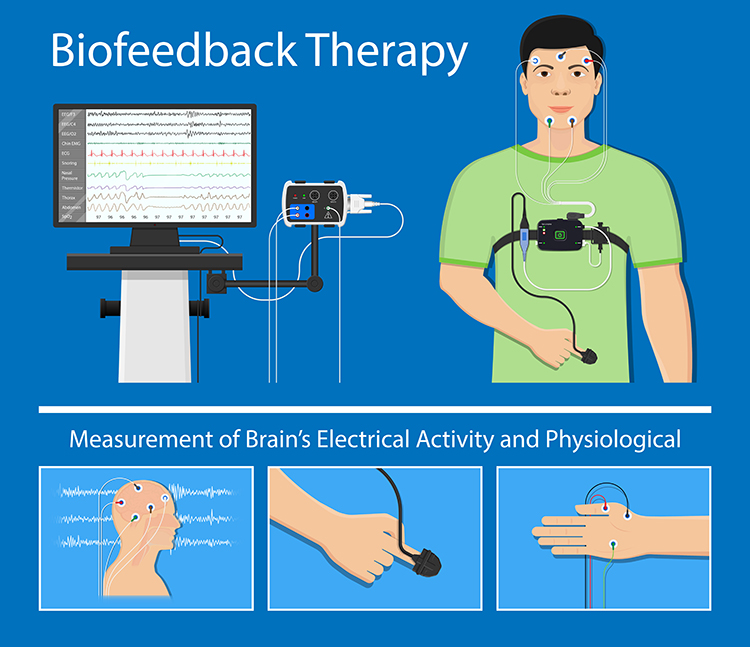
We can think of biofeedback as a "psychophysiological
mirror" that teaches individuals to monitor, understand, and change their physiology (Peper, Shumay, &
Moss, 2012).
Biofeedback training aims to teach self-regulation, which is control of behavior without feedback.
For example, a client could use a mirror or a position sensor on their back (e.g., biofeedback) to practice keeping the chin level. When they have practiced sufficiently to achieve good posture without reminders, this shows that they have achieved self-regulation. Biofeedback training is a bridge to self-regulation. Graphic © fizkes/Shutterstock.com.

Biofeedback is information that can be used to guide and improve performance.
While biofeedback training is a powerful intervention in clinical disorders, it is increasingly used to promote optimal performance. Graphic © LDprod/Shutterstock.com.

Biofeedback training may be more effective when training promotes mindfulness.
Mindfulness involves "paying attention in a particular way: on purpose, in the present moment, and nonjudgmentally" (Kabat-Zinn, 1994).
A mindfulness approach
teaches clients to focus on their immediate feelings, cognitions, and sensations in an accepting and non-judgmental way, to distinguish between what can and cannot
be changed, and to change the things they can (Khazan, 2013). Mindfulness guides the trial-and-error process underlying self-regulation by helping clients draw connections between their actions, internal feedback, and results. Graphic © fizkes/Shutterstock.com.
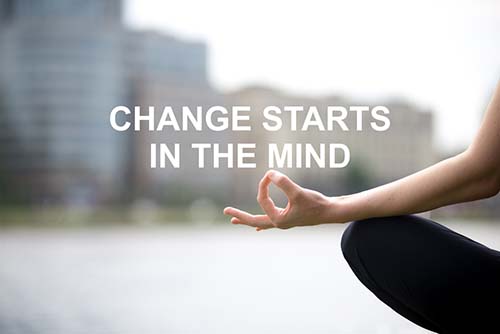
Clients can become
stuck when they focus on outcomes they cannot immediately control. For example, Jane was diagnosed with elevated blood pressure. When she measured her pressure several times a day, her anxious attention increased these values and amplified her anxiety. Heightened anxiety, in turn, interfered with her practice of slow-paced breathing. She could not focus on his breathing while she worried about her hypertension. Her blood pressure gradually decreased when Jane learned to accept her high blood pressure without fear, reduce her measurement frequency to once a day, and focus entirely on healthy breathing. Jane succeeded by changing what she could; her breathing pattern. Graphic © Ivelin Radkov/Shutterstock.com.

A comprehensive view of health and optimal performance recognizes the importance of the interconnected domains of body, mind, and spirit. In this context, spirit can mean philosophical beliefs or soul. Graphic © Gustavo Frazao/Shutterstock.com.
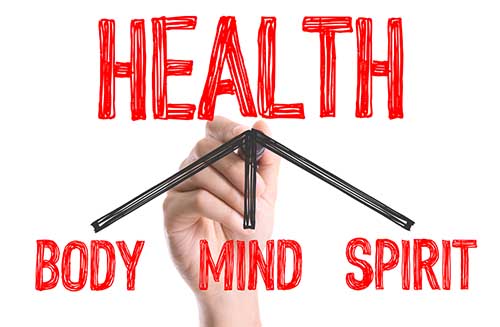 Neurofeedback
Neurofeedback, which is also called EEG biofeedback, is the process of interacting with an electronic device that measures and feeds back information about brain electrical activity via brainwave information. This process aims to ensure effective regulation by the neuromodulating systems of the brain, encourage global neurophysiological change, and correct specific, distinct, and identifiable disorders due to underlying dysregulation.
 What does neurofeedback do?
What does neurofeedback do? Neurofeedback provides accurate, timely, and useful information to the client. This information is displayed using visual, auditory, or tactile feedback that corresponds to meaningful changes in the monitored systems. Neurofeedback training encourages flexibility, resilience, and choice.
Neuroplasticity, the ability of neurons and their networks to
remodel themselves in response to experience, makes neurofeedback training possible (Breedlove & Watson, 2023). The learning mechanisms that underlie neurofeedback training depend on interrelated structural and functional changes. Neuroplasticity involves alterations in transmitter release and binding, modulation of transmitter release by interneurons, the formation and elimination of synapses, selecting among competing neural pathways, and strengthening and weakening the connectivity between brain regions.
BCIA Blueprint Coverage
This unit addresses
I. Orientation to Neurofeedback - D. Assumptions underlying neurofeedback.
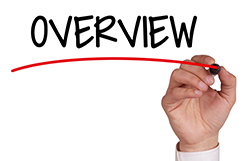
This unit covers Concepts of Feedback and Control, Basic Psychophysiology of Stress, and Basic Physiology of Attention.
Please click on the podcast icon below to hear a full-length lecture.
Concepts of Feedback and Control
Both biofeedback and neurofeedback are based on concepts of feedback and control found in cybernetic theory. Two everyday examples of feedback and control are radar speed displays and handheld thermometers.
A radar speed display shows motorists how closely their speed matches the posted limit. This example illustrates the concept of biofeedback. The device displays information about an
activity (speed) back to an
individual (a driver) to (hopefully) change speeding behavior. A
reward occurs when the display stops and shows the correct speed. Graphic ©Tada img/Shutterstock.com.
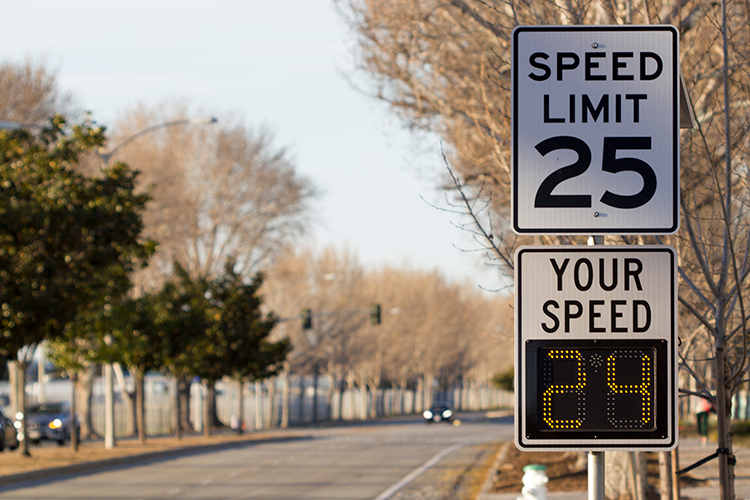
Handheld thermometers give you direct, bidirectional feedback (information) about your finger temperature, allowing you to practice increasing hand temperature.
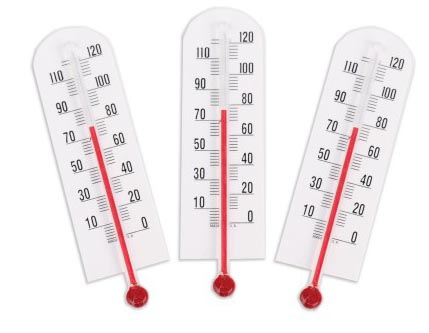
Cybernetic Model
The
cybernetic model proposes that "biofeedback is like a thermostat."
The term
biofeedback originated in cybernetic theory. Learning self-regulation requires accurate feedback about our physiology (Annett, 1969). Graphic © Maridav/Shutterstock.com.

The components of
a thermostat system include a
setpoint or goal (75
°
F/ 23.9
° C),
system
variable or what is controlled (room temperature),
negative feedback or
corrective instructions (commands to change furnace output), and
positive
feedback or instructions to continue action (orders to continue furnace
output).
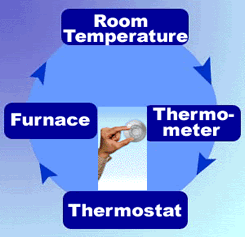
The internal environment fluctuates around a setpoint and is never
stationary. This allows rapid adaptation to changing activity levels and
environmental conditions. Homeostasis is
a state of dynamic constancy achieved by stabilizing
conditions above and below a setpoint, which may change over time. From
the perspective of the cybernetic model, biofeedback training supplements
a client's proprioception to bring a malfunctioning biological system
variable (blood pressure) under better control (Fox, 2019).
Homeostasis depends on sensory systems (networks that monitor system
variables) to detect an actual or anticipated
change in physiological processes (temperature), an
integrating center,
which receives input from many sensors, and multiple effector systems
(control systems) to
adjust physiological processes.
The body maintains dynamic constancy through continuous negative feedback
loops amplified by positive feedback and antagonistic effectors.
Negative feedback loops produce corrective changes when a physiological
variable is outside an acceptable range. For example, we initiate
clotting to stop blood loss from a wound.
Positive feedback loops amplify the changes produced by negative feedback.
For example, activating one clotting factor activates others to create
a blood clot.
Push-pull control by effectors that produce antagonistic effects achieves
more precise control than turning a single effector on or off. For
example, a sympathetic nerve accelerates the heart while the
parasympathetic vagus nerve slows the heart.
BASIC PSYCHOPHYSIOLOGY OF STRESS
Stress can be confusing
since it can refer to a stimulus, response, a transaction. The stress response is multidimensional, there are multiple stress responses, and individuals often show a characteristic response pattern. The
conceptualization of the stress response as
nonspecific is misleading since clients may have unique stress
triggers (time pressure) and specific psychophysiological
changes (blood pressure spikes).
While early theories of stress
emphasized the role of stimuli, more recent theories focus on our
cognitive appraisal of events and coping resources. The biopsychosocial
model has replaced the aging biomedical model due to its greater
comprehensiveness and support for interdisciplinary treatment of
disorders. Likewise, the allostatic load model has replaced Selye's General Adaptation System framework for understanding the role of stress in disease. Graphic © Arseniy Krasnevsky/Shutterstock.com.

Chronic stress reduces heart rate variability (HRV). "HRV is the organized fluctuation of time intervals between successive heartbeats defined as interbeat intervals" (Shaffer, Meehan, & Zerr, 2020). We measure the time intervals between successive heartbeats in milliseconds. Graphic adapted from Dr. Richard Gevirtz.
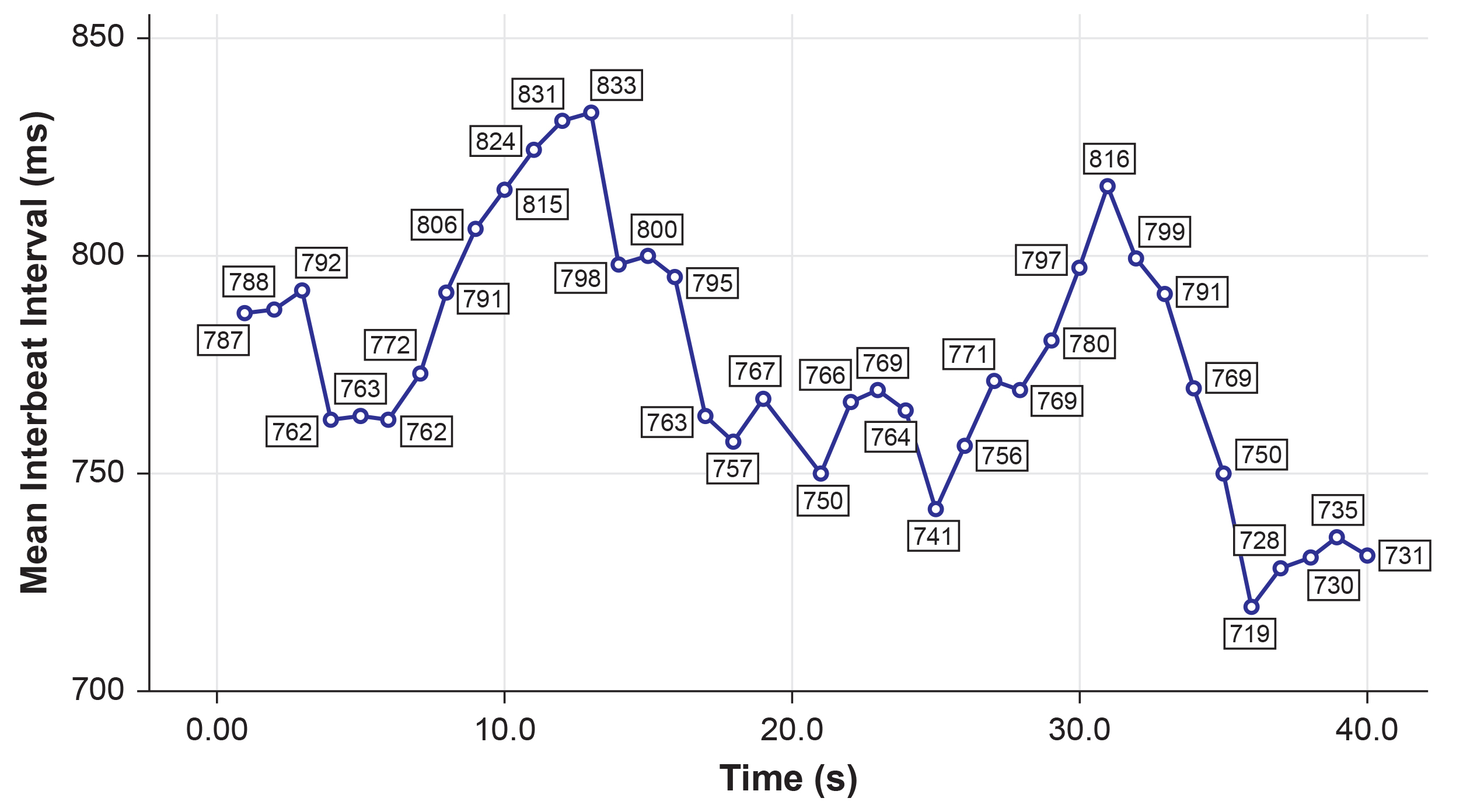
HRV is crucial to health, performance, and resilience. Low HRV is a marker for cardiovascular disorders, including hypertension, especially with left ventricular hypertrophy; ventricular arrhythmia; chronic heart failure; and ischemic heart disease (Bigger et al., 1995; Casolo et al., 1989; Maver et al., 2004; Nolan et al., 1992; Roach et al., 2004). Low HRV predicts sudden cardiac death, particularly due to arrhythmia following myocardial infarction and post-heart attack survival (Bigger et al., 1993; Bigger et al., 1992; Kleiger et al., 1987).
Reduced HRV may predict disease and mortality because it indexes reduced
regulatory capacity, which is the ability to surmount challenges like exercise and stressors. Patient age may be an essential link between reduced HRV and regulatory capacity since both HRV and nervous system function decline with age (Shaffer, McCraty, & Zerr, 2014).
BCIA Blueprint Coverage
This unit addresses
Models of stress and illness (II-A),
Psychophysiological reactions to stressful events (I-B), and
Psychosocial mediators of stress (I-C).

This unit covers Stressors and Stress, The Stress Response is Multidimensional, Biopsychosocial Model, Allostatic Load Model, Stress-Diathesis Model, System-Wide Effects of Stress, Stressful Life Events, Psychological Factors in Stress, Acute and Chronic Stress Responses, Psychoneuroimmunology, Cognitive Appraisal of Stressors and Coping, Personality Dimensions, and Resources to Buffer Stress.
Stressors and Stress
Cannon (1939) studied how environmental stressors like cold temperatures and loss of oxygen trigger a fight-or-flight response. He conceptualized
stress as the
disruption of homeostasis when the body mobilizes the sympathetic nervous system and endocrine system to deal with external threats.

Selye (1956) also studied environmental challenges to homeostasis. He referred to
stress (and
strain) as emotional and physiological responses to stimuli called
stressors.
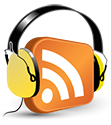
Listen to a mini-lecture on Stressors and Stress © BioSource Software LLC.
Selye conceptualized stress as a nonspecific response.
Selye conceptualized these
responses as
nonspecific since many
stimuli can produce the same physiological changes. He theorized that negative and positive stimuli could
provoke stress responses requiring coping resources. He termed stress due to aversive stimuli,
distress, and positive events,
eustress (Moksnes & Espnes, 2016).
The
Yerkes-Dodson curve graphs the relationship between stressors and performance. The left side of the inverted U-curve depicts an underload where an individual is insufficiently challenged and bored. This phenomenon of low motivation and performance has been termed
rust out and reminds us that we require stressors for motivation and creativity (O'Dowd, 1987). The middle region that ends with peak performance corresponds to eustress. An optimal level of challenge promotes focus, motivation, and creativity. The right side of the curve represents the worsening effects of excessive pressure, overload, and burn-out with anxiety, panic, and anger. Graphic © Olivier Le Moal/Shutterstock.com.
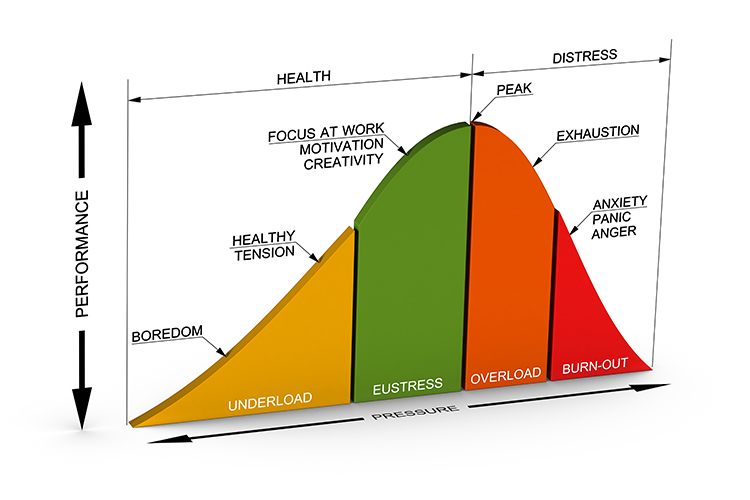
Evaluation
Selye's model excluded psychological factors like
appraisal. His assumption that stress involves nonspecific physiological changes is incorrect. All stressors do not produce a uniform endocrine stress response. Instead, stressors can change multiple body systems in response to stressor intensity, biological predisposition, cognitive appraisal, perceived support, and emotional response (Mason, 1971, 1975; McEwen, 2005; Taylor, 2021). Finally, whereas Selye proposed that our stress responses attempt to maintain physiological processes within a narrow optimal range, current research focuses on adaptation (e.g., allostatic load model) instead of set points (Brannon et al., 2022).

The Stress Response Is Multidimensional
The human stress response is multidimensional and involves diverse systems, ranging from the central nervous
system to the immune system. Each person uniquely responds to stressors. This individualized pattern is called
response stereotypy. Individuals differ in the systems impacted, their activation or suppression, and how these changes affect health. While stressors can produce system-wide macroscopic changes like increased blood pressure, they can also cause
epigenetic changes that alter DNA expression. Graphic © Sergey Nivens/Shutterstock.com.
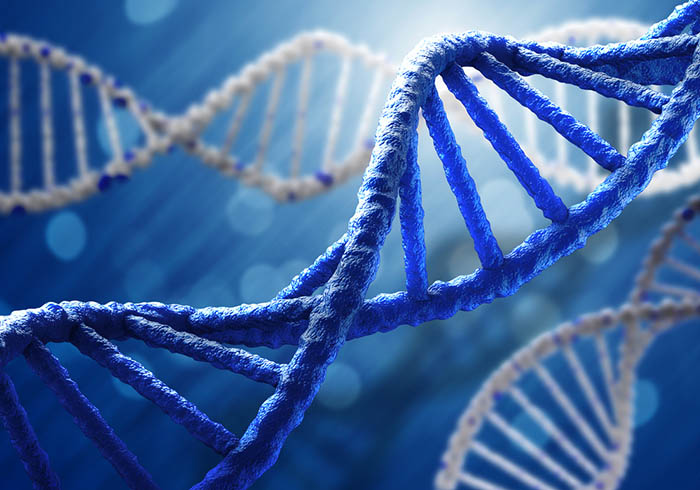
Sympathetic and Parasympathetic Responders
Two modal patterns of autonomic response to stressors have been observed. A
sympathetic responder may
increase blood pressure, heart rate, and sweat gland activity and decrease heart rate variability and peripheral
blood flow. These changes may result from increased sympathetic activation, decreased parasympathetic
activation called
vagal withdrawal, or a combination of both.

Listen to a mini-lecture on Sympathetic and Parasympathetic Responders © BioSource Software LLC.
In contrast, a
parasympathetic responder may increase digestive activity,
constrict the lungs' alveoli, and faint from low blood pressure.
Individuals can react to stressors with elements of both autonomic patterns. For example, they can increase heart rate and blood pressure (sympathetic) while experiencing the gastrointestinal symptoms of diarrhea and gas (parasympathetic).
Stephen Porges proposes that vagal withdrawal is our modal response to everyday stressors. Real Genius is drawn by Dani S@unclebelang.
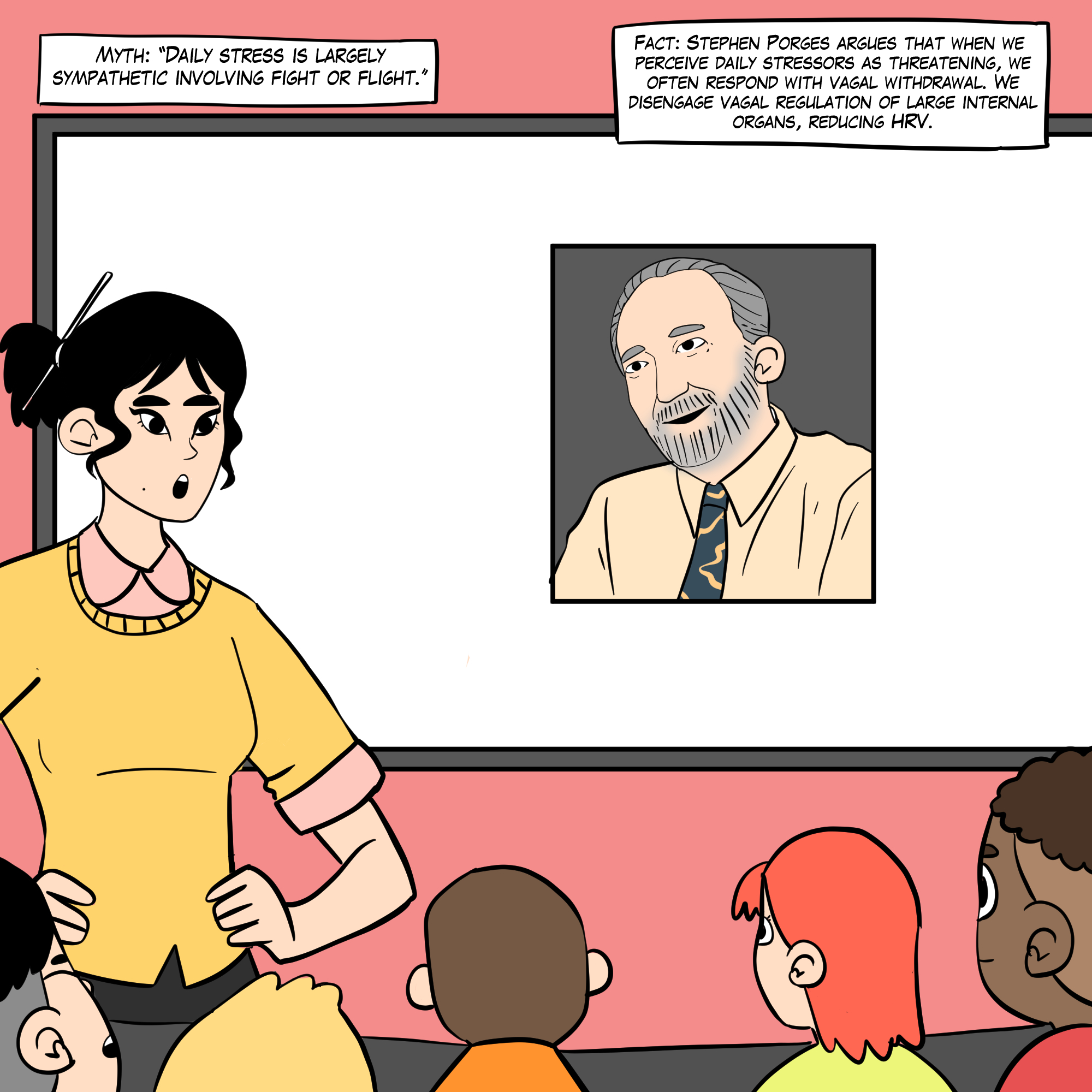
Hawks and Doves
Individuals differ in their behavioral activation when confronted by a stressor. While
behavior is activated in the "fight-or-flight" response, it is suppressed in the "freeze-hide"
response. The dazed young man illustrates passive parasympathetically-mediated freezing. Graphic © Dean Drobot/Shutterstock.com.

Evolutionary biologists have called active and passive responses "hawk" and "dove" strategies. Graphic © jimkruger/ iStockphoto.com.
 Hawks
Hawks are described as "proactive and bold," while
doves are passive,
reactive, nonaggressive, and cautious. Hawks appear to utilize the "fight-or-flight" response and
activate the sympathetic-adrenomedullary (SAM) pathway. Doves, in contrast, activate the hypothalamic-pituitary
(HPA) axis (Woolfolk et al., 2007).
Men and women may respond differently to stressors. Studies of hormonal secretion during sports competition
(Kivlinghan et al., 2005) and children's reactions to threatening behavior by their mothers (David
& Lyons-Ruth, 2005) support the hypothesis that men are more likely to flee while women prefer to
affiliate. Graphic © lassedesignen/Shutterstock.com.

Stress-related disorders are more prevalent in women than men in the US (Gaidos, 2016).
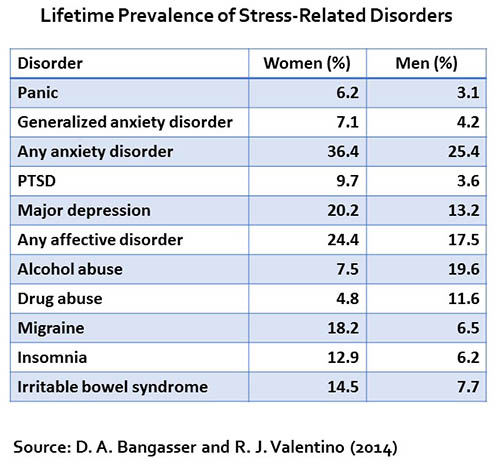
Corticotropin-Releasing Hormone (CRH)
The stress hormone
corticotropin-releasing hormone or factor (CRH/CRF) is a hormone and neurotransmitter. Threats and intense emotional responses cause the brain to secrete CRH to increase attention and mobilize to cope with a threat. The brain releases CRH at the prefrontal cortex (attention and executive functions), the amygdala (anxiety, fear, and emotional memories), and the hippocampus (declarative memories). The hormones estrogen and progesterone in females and testosterone in men may influence the brain's response to CRH.
Bangasser (2013) reported evidence from studies with rodents that males reduce the number of postsynaptic CRH receptors following a stressor, while females do not. Female rodents' brains are more responsive to elevated CRH levels, and this prolonged response may result in hypervigilance. Chronic high levels of stress hormones can modify DNA via epigenetic mechanisms (like DNA methylation) to increase vulnerability to disorders like anxiety and depression (Gaidos, 2016).
Oxytocin
The
medioventral bed nucleus of the stria terminalis (near the hypothalamus) regulates anxiety and teaches us to avoid stress-related locations or situations. When strangers bully female rodents, they increase the number of oxytocin-secreting neurons and oxytocin levels in the stria terminalis. Following stressful events,
oxytocin may increase anxiety to a greater degree in female than male rodents. Women diagnosed with PTSD have elevated plasma levels of oxytocin (Gaidos, 2016).
Neurosecretory cells in the hypothalamus synthesize oxytocin released by terminals located in the posterior pituitary (Breedlove & Watson, 2023). Graphic © Designua/Shutterstock.com.
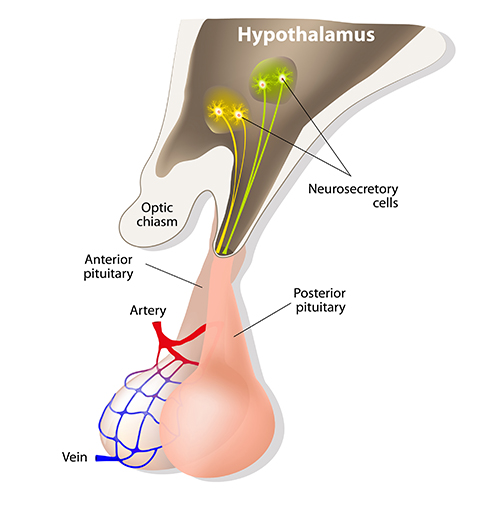
Biopsychosocial Model
Engel's
(1977, 1980)
biopsychosocial model
proposes that the complex interplay of psychological, biological,
and sociological factors results in health or illness.
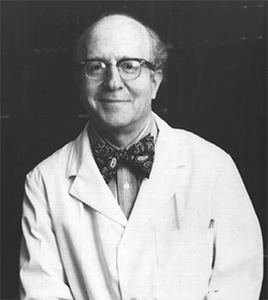
In this model,
stress is a psychological risk factor that affects and is influenced by
an individual's biology and sociology. The biopsychosocial model
challenges the
biomedical model
that illness is primarily due to biological abnormalities,
which has influenced medical practice since the 1700s (Taylor, 2012).
A clinician who adopts the biopsychosocial model assumes that health depends on all three factors. When treating illness, these factors must be assessed and addressed using an interdisciplinary approach (Schwartz, 1982).
The illustration below was adapted from Brannon et al. (2022).
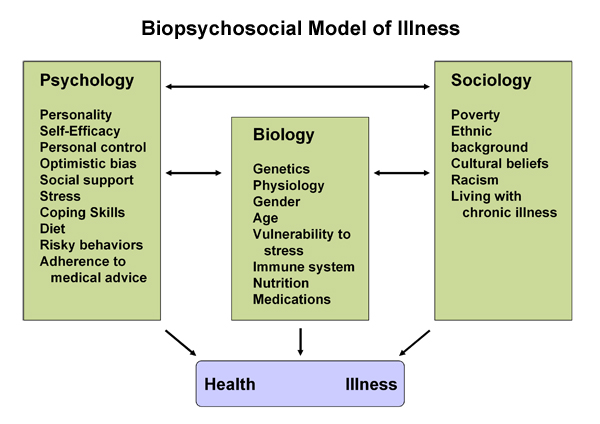
Evidence supporting the biopsychosocial model includes increased psychological and medical disorders in divorced and bereaved persons (Schneider, 1984).
Allostatic Load Model
Allostasis, which means achieving stability through change, involves matching
type
(sympathetic or parasympathetic) and intensity of physiological
activation to situational demands (Brannon et al., 2022).
McEwen and Seeman's (1999)
allostatic load model
proposes that biological responses to stress (e.g., cortisol secretion or elevated glutamate transmission) can harm the body when stressors are chronic or repeatedly occur. Over time, the stress response itself may overwhelm the body's adaptive capacity.

Caption: Bruce McEwen
Allostatic load can produce growing changes during childhood, increasing health risks across the life cycle (Wiley et al., 2016). It can prematurely age the body. Chronic stress may suppress cell-mediated
immunity, reduce hippocampal control of cortisol during stress, lower heart rate variability (HRV), raise plasma
epinephrine, increase the waist-to-hip ratio, reduce hippocampal volume, impair cognitive performance (e.g., memory), increase plasma
fibrinogen, raise blood pressure, and increase the risk of illness and death (Juster et al., 2010; Karlamangla et al.,
2006; McEwen & Gianaros, 2010). Table adapted from Seeman et al. (1997) and Taylor (2021).
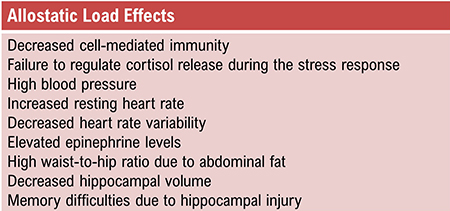
Researchers have linked high allostatic load to illness in children and the elderly (Johnston-Brooks et al.,
1998; Seeman et al., 1997). The damage produced by allostatic load can be amplified by decreased healthy behaviors
(e.g., exercise) and increased unhealthy behaviors (e.g., binge drinking and smoking) (Ng & Jefferey,
2003). High allostatic load can produce burnout. Burnout graphic © elenabsl/shutterstock.com.
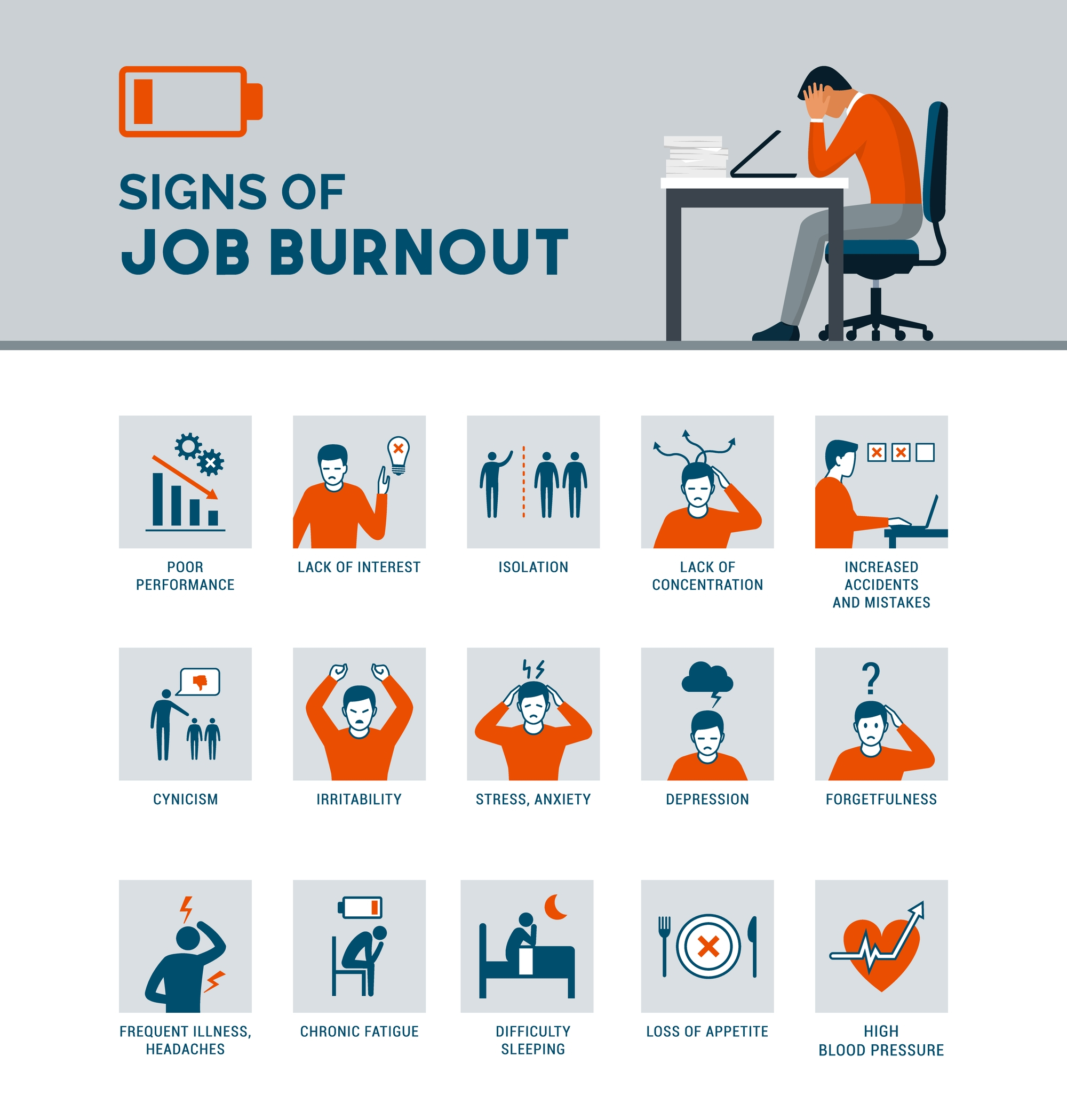
Check out Sapolsky's superb National Geographic YouTube video
Stress, Portrait of a Killer.
Stress-Diathesis Model
The
stress-diathesis model explains
that stressors interact with our inherited or acquired biological
vulnerabilities,
diatheses, to
produce medical and psychological symptoms. From this perspective,
disease results when an individual is predisposed to disease and
experiences stress. Life event scales like the SRRS and USQ may achieve
low predictive validity because they only and incompletely assess
stress; they do not evaluate illness vulnerability (Marsland et al.,
2001).
The interrelationship among stress, insomnia, and depression illustrates the stress-diathesis model.
Sleep reactivity, the tendency for sleep to be disrupted by stress, appears to be a shared vulnerability in insomnia and depression. Greater sleep reactivity produces insomnia, and insomnia contributes to depression. Chronic insomnia can also increase blood pressure, blood sugar levels, and weight (Drake et al., 2014).
System-Wide Effects of Stress
Stress and the Microbiome
The human body primarily comprises single-celled organisms, which outnumber our human cells 1.3-to-1 (Sender et al., 2016). Viruses vastly outnumber bacteria and could sharply increase microbe-to-human cell ratio (Saey, 2016). Most human bacteria are located in our gut. The human
microbiome is the collection of microorganisms that reside in our bodies. Graphic © Kateryna Kon/Shutterstock.com.
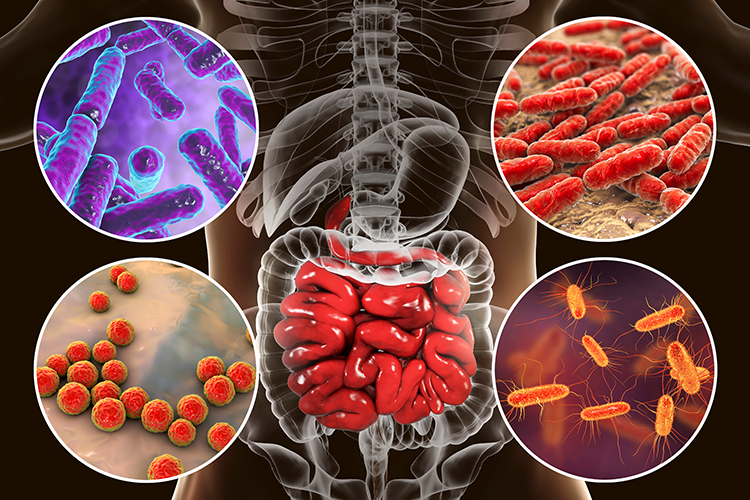
Research using rodents suggests that the 40 trillion bacteria in our microbiome may influence brain development, neurotransmitter synthesis, emotions, pain thresholds, and response to stressors. In rodents, shifts in the microbiome's ecology can produce more exploratory or cautious behavior.
 Listen to a mini-lecture on the Microbiome
Listen to a mini-lecture on the Microbiome © BioSource Software LLC.
Microbiome graphic © Alpha Tauri 3D Graphics/shutterstock.com.

The relationship between the brain and gut biome appears to be bidirectional. While the brain and gut microbiome probably communicate using several pathways, the 100 million enteric system neurons which regulate the GI tract may prove to be a crucial nexus. Mild stress can reduce the number of beneficial bacteria. Severe chronic stress might contribute to the development of disease. While researchers struggle to define a healthy gut microbiome's characteristics, evidence suggests that disorders like anxiety and depression may be associated with abnormal microbiota (Carpenter, 2012).
Enteric nervous system graphic © Lightspring/shutterstock.com.
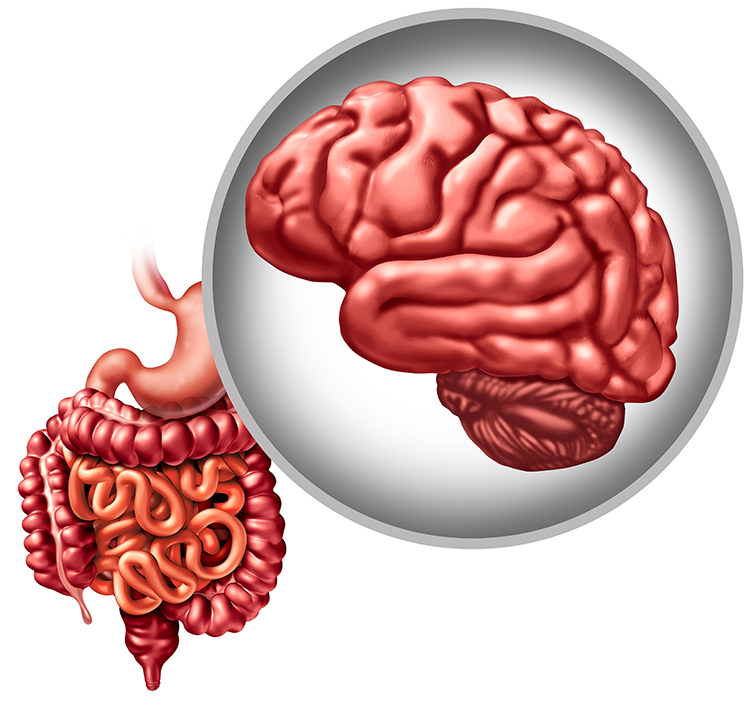
Protein Kinase C
Birnbaum and colleagues (2004)
reported that uncontrollable stressful situations activate the enzyme
protein kinase C (PKC), interfering
with prefrontal cortical functions like working memory. Elevated PKC
levels may result in symptoms of distractibility, impulsiveness, and
poor judgment seen in bipolar disorder and schizophrenia. Initial
psychotic episodes often follow stressors like leaving home for college
or the military. Very low levels of lead exposure can elevate PKC levels
in children, possibly impairing their regulation of behavior and
producing distractibility and impulsivity.
Stress Accelerates Aging
Epel and colleagues (2004) studied
58 healthy women who cared for either healthy or chronically ill
children.
The
researchers administered a brief questionnaire that assessed chronic
stress during the previous month and obtained a blood sample to measure
telomere (DNA and protein that cover
the ends of chromosomes), length, and levels of
telomerase (an enzyme that adds DNA to telomeres). Graphic © Designua/Shutterstock.com.
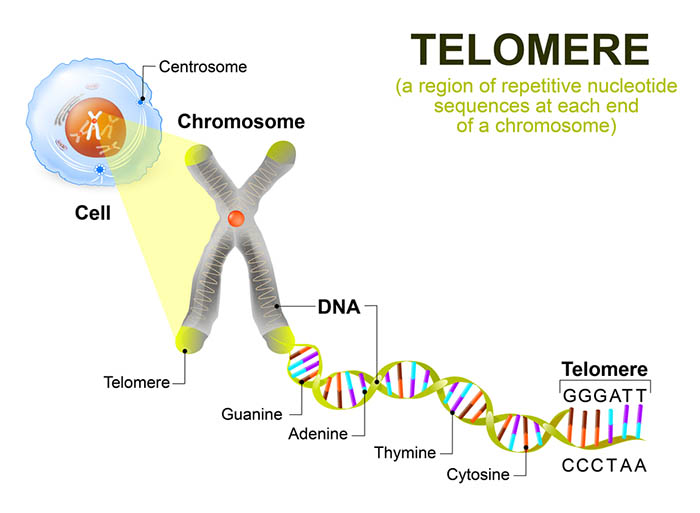
With
repeated cell division, telomere DNA is lost, the telomere shortens, and
eventually, cell division stops. When cells age, telomerase activity
declines, and the telomere shortens. Graphic © koya979/ Shutterstock.com.
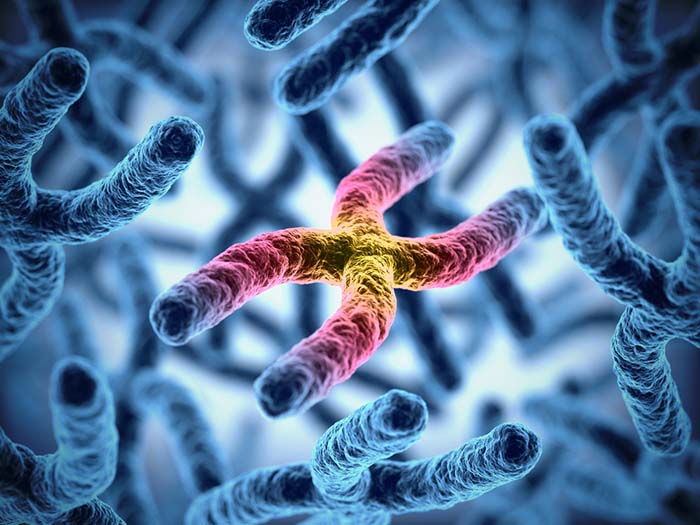
The researchers found that the mothers of chronically ill children
reported higher chronic stress levels than mothers of healthy children.
More years of caring for chronically ill children were correlated with
shorter telomeres and lower telomerase levels. Perceived levels of
chronic stress—and not a child's actual health status—predicted telomere
length. The researchers calculated that the cells of high-stress mothers
had aged 9 to 17 more years than those of the low-stress mothers.
Stress May Contribute to Mild Cognitive Impairment
Older adults enrolled in the Einstein Aging Study who reported high stress levels were twice as likely to exhibit the memory deficits associated with mild cognitive impairment (MCI), which may precede Alzheimer's (Katz et al., 2015).
Stressful Life Events
Cataclysmic Events
Lazarus and Cohen (1977) described
cataclysmic events as "sudden, unique, and powerful single life-events requiring major adaptive responses from population groups sharing the experience” (p. 91).
Intentional and unintentional, these events can impact local communities (e.g., mass shootings), geographic regions (e.g., earthquakes, fires, hurricanes, and tsunamis), and the entire planet (e.g., the COVID-19 pandemic. These catastrophes can produce death, dislocation, fear, grief, trauma, and Post-Traumatic Stress Disorder. Graphic © Syda Productions/Shutterstock.com.

Many factors influence survivor response to these powerful stressful events, including perceived discrimination, resources, support, vulnerability to future harm, distance from the devastation, and media coverage. The stressfulness of an event is influenced by geographic proximity, its recency, and whether it was intended. Intentional events are more traumatic than natural disasters because the perpetrators targeted the victims and could do so again (Brannon et al., 2022).
Life Events
Cataclysmic events like a pandemic are so disruptive become they change our lives in various ways: education, employment, exercise, personal, family member, and friend illness, routines, sleep, social interaction, and working conditions.
Life events differ from cataclysmic events in
three ways. They affect fewer individuals. They require adjustment, whether positive (e.g., the birth of a child) or negative (e.g., the death of a loved one). Last, they can develop more slowly (e.g., divorce) or suddenly (e.g., injury in a car crash).
Holmes and Rahe (1967) measured major positive and negative
life changes using their
Social Readjustment
Rating Scale (SRRS). The scale lists 43 events, each assigned
a different Life Change Unit (LCU) value. They arranged these events in
descending order from the death of a spouse (100 LCUs) to minor law violations (11 LCUs). Individuals select the events they have experienced
within the last 6 to 24 months. Researchers calculate a stress score by
summing the LCU value of the checked events.
Studies that combine
prospective (subjects report current events) and retrospective methods
(researchers examine subsequent health records) have reported increased
illness and accidents following increased stressful events (Johnson,
1986; Rahe & Arthur, 1978). However, the correlation between SRRS scores
and disease is around + 0.30 (Dohrenwend & Dohrenwend, 1984), which means
that the SRRS accounts for only 9% of the variance in disease.

Listen to a mini-lecture on the Effects of Major Life Changes and Hassles © BioSource Software LLC.
The SRRS has received severe criticism, and its popularity
has declined. Critics have argued that its positive events can
reduce the risk of illness (Ray, Jefferies, & Weir, 1995). Many individuals who exceed 300 points in a year
remain healthy. Scales like the SRRS underestimate African-American life stress (Turner & Avison, 2003). The
SRRS
assumes that an event impacts all people equally. The wording of some
items is vague (e.g., "change in responsibilities at work"). Pessimism
can distort recollections of life events (Brett et al., 1990). Finally, the
scale does not consider whether an event has been resolved (Turner &
Avison, 1992) or an event's controllability or probability (Gump & Matthews,
2000).
The
Undergraduate Stress Questionnaire (USQ) developed by Crandall and colleagues (1992) instructs students to select events
—mostly
hassles—they have experienced during the past two weeks. Higher
USQ scores are associated with increased use of health services.
The
Perceived Stress Scale (PSS) developed by Cohen
and colleagues (1983) measures perceived hassles, major life changes, and shifts in coping
resources during the previous month using a 14-item scale. PSS items
assess the degree to which respondents rate their lives as unpredictable,
uncontrollable, and overloaded (p. 387). The PSS achieves good
reliability and validity (Brannon et al., 2022). PSS scores predict
cortisol levels (Harrell et al., 1996), fatigue, headache, sore
throat (Lacey et al., 2000), and immune changes (Maes et al., 1997).
Hassles and Uplifts
A
hassle is a minor stressful event
like waiting in a checkout line or experiencing a traffic jam.
Hassles can produce illness via several pathways. First, hassles can cause accumulating allostatic load. Second, hassles can amplify the effects of adverse life events and chronic stress (Marin et al., 2007; Serido et al., 2004; Taylor, 2021). Graphic © Dmitry Kalinvosky/Shutterstock.com.

Graig's (1993) concept of
urban press illustrates how ever-present environmental stressors (e.g., alienation, crowding, fear of crime, noise, and pollution) acting in concert as daily hassles can increase death from heart attacks (Christenfeld et al., 1999). As with stressors in general, an individual's perception of daily hassles like noise and population density determines their effects on behavior, health, and performance (Brannon et al., 2022; Evans & Stecker, 2004; Schell & Denham, 2003). For example,
crowding is our perception of density, influenced by our perceived degree of control. Graphic © Wachiwit/Shutterstock.com.

Discrimination experienced in the classroom, community, family, media, and workplace is another source of daily hassles. Discrimination based on age, biological sex, ethnicity, gender identity, and religion can disadvantage and physically endanger individuals and threaten their mental and physical health (Brannon et al., 2022; Pascoe & Richman, 2009; Troxel et al., 2003). Discrimination has elevated the risk of suicide in the bisexual, gay, lesbian, and transgender communities (Haas et al., 2011). Further, Anti-Asian hate has resulted in a wave of attacks against Asian Americans. Graphic © myboys.me/shutterstock.com.

The framework of
intersectionality proposes that social identities (e.g., biological sex, class, gender identity, and race) interact to produce discrimination, disadvantage, or advantage. For example, a white woman with a disability may encounter sexism and ableism, while a Black transgender woman with the same disability may experience the former discrimination and transphobia. Their lived experiences will differ because their unique identities intersect, creating different patterns of discrimination and access barriers (Surrey Place-Staff, 2021). Graphic courtesy of Womankind Worldwide.
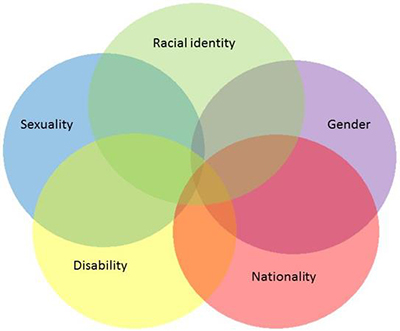
An
uplift is a
minor positive event like receiving an unexpected call from a friend or playing with new puppies. Graphic © Orientgold/Shutterstock.com.

Kanner and colleagues (1981) developed a 117-item Hassles Scale
and 138-item
Uplifts Scale to measure negative and
positive daily experiences. Respondents selected the hassles and
uplifts they experienced during the previous month. Next, they rated the
degree to which they experienced each selected item on a 3-point scale to
assess their perception of each stressor. They found a moderate
correlation between hassles and major life changes. Lazarus (1984) reported that the Hassles Scale better
predicted psychological health than major life changes.
DeLongis and colleagues (1988) replaced the Hassles and Uplifts Scales
with a 53-item revised Hassles and Uplifts Scale.
Respondents selected the items they experienced that day and rated each
item using a 4-point scale (none to a great deal). The
revised Hassles Scale better predicted headache frequency and intensity
(Fernandez & Sheffield, 1996) and inflammatory bowel disease frequency
(Searle & Bennett, 2001) than the Social Readjustment Rating Scale. Consistent with Lazarus's
emphasis on the appraisal of events, the perceived intensity of hassles
better predicted headache symptoms than the number of hassles.
The interaction between hassles and chronic stress is complex. Hassles
may increase the psychological distress produced by chronic stress (Serido et al., 2004). Conversely, chronic stress may reduce the
effects of hassles by placing them in perspective (McGonagle & Kessler,
1990).
Hardiness
Some individuals do not experience illness or psychological distress when exposed to adverse life events and hassles. Although they may experience brief distress, they generally recover (Lehrer, 2021). Researchers use the concept of
hardiness to explain these outliers (Maddi, 2017; Maddi et al., 2017; Pitts et al., 2016; Stoppelbein et al., 2017). Graphic ©lassedesignen/Shutterstock.com.

The hardiness concept emerged from a 12-year study of manager stress responses at the Illinois Bell Company (Maddi, 1987). Halfway through the study, their parent company's reorganization eliminated half their employees within a year. Two-thirds of the managers experienced severe stress reactions (e.g., heart attacks, depression, and suicide), and one-third thrived. The investigators concluded that the hardy managers were protected by attitudes of commitment (strong involvement), control (internal locus of control), and challenge (learning from experience and accepting change).
Hardiness involves biological (McVicar et al., 2014; Oken et al., 2015; Parkash et al., 2017) and social factors (Kuzman & Konopak, 2016; Zeer et al., 2016). Longitudinal studies suggest that infants' autonomic and emotional reactivity predicts later emotional reactivity (Berry et al., 2012; Cohen, 1989; Raby, 2016; Wagner et al., 2017). Less reactive infants may become more resilient. In addition, cohesiveness and social support (actual and perceived) may buffer hardy individuals against stressors. Graphic © Nina Buday/Shutterstock.com.

Psychological Factors in Stress
Traumatic Stress and Post-Traumatic Stress Disorder (PTSD)
Traumatic stress is produced by a highly intense stressor that disrupts coping and endangers ourselves
or others.
Post-Traumatic Stress Disorder (PTSD)
is a severe and long-lasting trauma and stressor-related disorder that often develops within
three months of a traumatic event. DSM-5 (APA, 2013) divides its symptoms into four clusters: intrusion, avoidance, negative alterations in cognitions and mood, and alterations in arousal and reactivity. Graphic © John Gomez/Shutterstock.com.
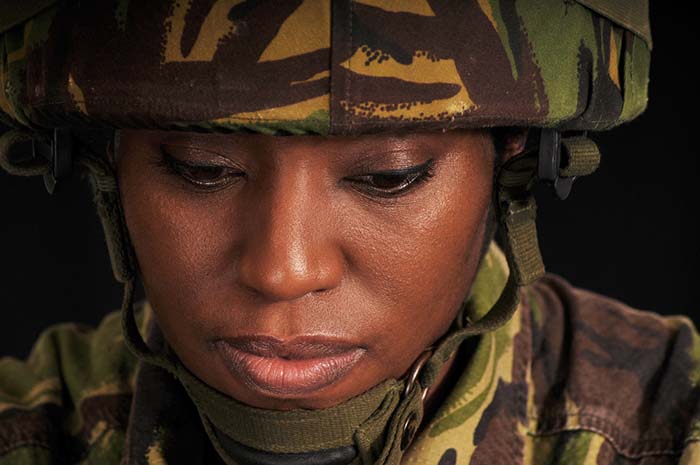
The exposure can
also be second-hand, such as witnessing domestic violence or learning about a
family tragedy (Crider, 2004; Lamprecht & Sack, 2002). The lifetime prevalence of adult PTSD
in the United States is about 6.8% (Kessler et al., 2005).
While the earliest model of PTSD focused on trauma during combat,
subsequent research has shown that crime, domestic violence, natural
disasters, sexual assault, and terrorism can precipitate PTSD symptoms.
Since women are more likely than men to experience these stressful
events, it should not be surprising that they are more often diagnosed
with this disorder (Stein et al., 2000). Children and adolescent victims
and witnesses of violence also share an elevated risk of PTSD (Silva et
al., 2000).
A single traumatic event can reshape synapses and increase electrical activity in the amygdala 10 days later. The
N-methyl-D-aspartate receptor (NMDA-R) protein, which plays a central role in long-term memory, mediates these changes (Yasmin et al., 2016). Amygdala graphic © Kateryna Kon/ Shutterstock.com.
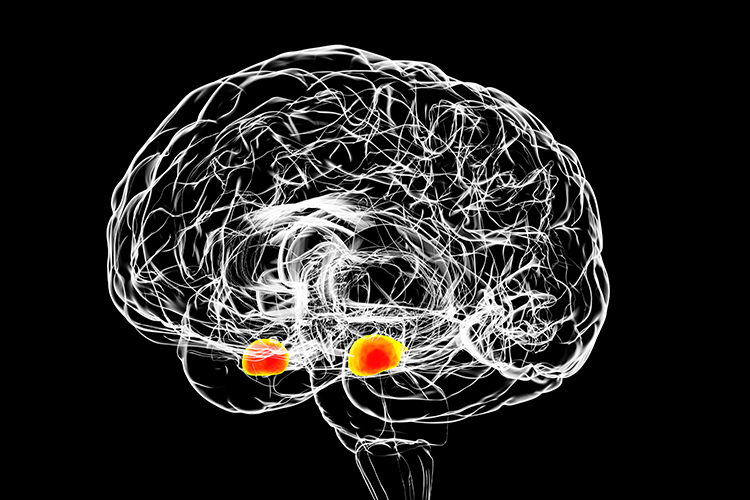
Children with depression experience trauma (35 percent) and bullying (29 percent) (Advokat, Comaty, & Julien, 2014). Graphic © fasphotographic/Shutterstock.com.

Intentional acts may produce more widespread distress than natural disasters because they threaten future and more
devastating attacks. The impact of a catastrophic event depends on your distance from the event, the time interval
since the event, and the perpetrators' perceived intentions (Brannon et al., 2022).
PTSD can permanently damage the systems that regulate our stress
response, particularly the amygdala and hypothalamic-pituitary-adrenal
(HPA) axis. Patients experience increased cortisol
level fluctuation and persistent epinephrine, norepinephrine,
testosterone, and thyroxin elevation (Taylor, 2006).
PTSD may promote medical illness through persistent immunosuppression
(Kawamura et al., 2001). Military veterans diagnosed with PTSD have a
greater risk of developing severe diseases following discharge than
veterans without PTSD (Deykin et al., 2001). PTSD may also exacerbate
pre-existing health problems. PTSD resulting from the September 11, 2001,
World Trade Center attacks may have helped worsen asthmatic symptoms in
New York residents (Fagan et al., 2003).
Negative Affect States and Affectivity
From a mindfulness perspective, we should not consider emotional responses like depression as negative but as difficult emotions. A clinician would encourage clients to accept depressed feelings as part of themselves without judgment and to focus on specific behaviors that can be changed (Khazan, 2013).
Stressors can trigger complex adjustments, including challenging affective states (anxiety) and corresponding
psychophysiological changes (decreased HRV). Barrett and Russell's
(1998)
structural model represents each affective state within a circumplex
based on its degrees of
affective valence (unpleasant to pleasant) and
affective intensity (activation to deactivation). Affective states
fall inside or along the surface of this circular structure. Diagram adapted from Russell and Barrett
(1999).
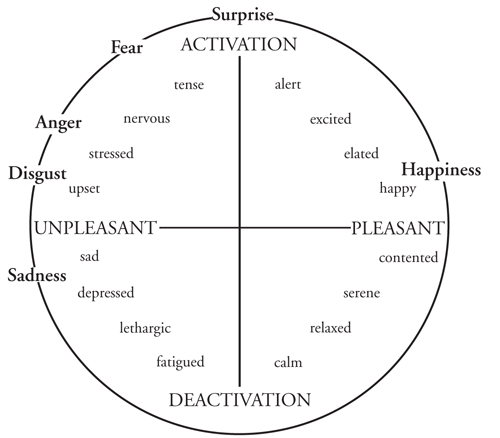
Negative states (sad) are located in the left hemisphere, and positive states
(contented) are located in the right hemisphere.
Activated states (tense) are
placed in the top hemisphere and
deactivated states (fatigued) are placed in
the bottom hemisphere. While adjacent affective states (stressed and nervous) most resemble each other, those 180°
apart (stressed and relaxed) are opposites. After clinicians identify their clients' position within the
circumplex, they may intervene to shift them to a more appropriate affective state, like relaxed instead of
nervous.
Researchers have reported psychophysiological correlates of the affective valence and activation dimensions.
Surface EMG (SEMG) and EEG can help assess affective valence. SEMG measurements of the zygomatic (smiling) and
corrugator (frowning) muscles are correlated with positive and negative affect (Lang et al., 1993). Higher
left/right prefrontal cortex activation ratios are correlated with positive affect, while reverse ratios are
correlated with negative affect (Sutton & Davidson, 1997). Sympathetic nervous system modalities like
electrodermal activity are associated with affective intensity (Crider, 2004; Lang et al., 1993).
Negative affectivity (neuroticism) is a
predisposition toward distress and dissatisfaction. Individuals
rated high on this trait negatively perceive themselves, others, and the
environment and have a pessimistic perspective. They rank more events as stressful, report more intense stress, complain more frequently about health problems, and report more severe symptoms when physically ill than those with lower negative affectivity (Cohen et al., 1995; Gunthert et al., 1999). Negative affectivity may increase
vulnerability to stressors and health conditions like anxiety and
depressive disorders they exacerbate (Brannon et al., 2022).
The
Type D (distressed) personality combines high levels of negative affectivity and social inhibition. Individuals rated high on this dimension cannot communicate their distress with others. Researchers have studied the relationship between negative emotionality and social inhibition and the Five-Factor Model of Personality. Negative emotionality is positively correlated with Neuroticism, whereas social inhibition is negatively correlated with Conscientiousness and Agreeableness (De Fruyt & Denollet, 2002). Five-Factor Model of Personality adapted from Sarafino et al. (2020).
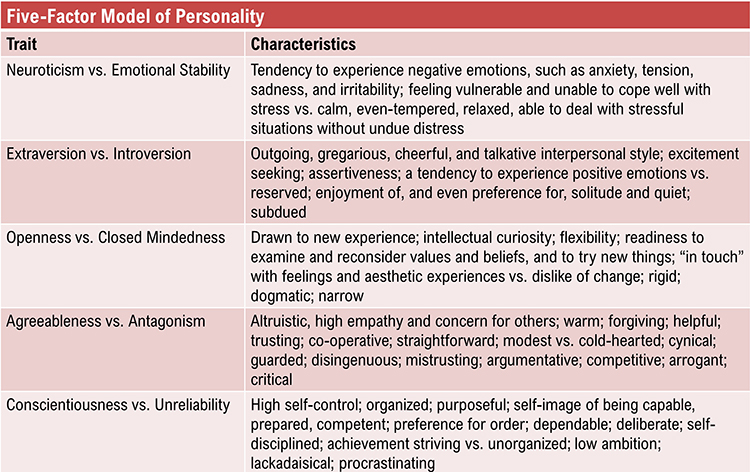
The Type D personality better predicted arterial plaque buildup than the Type A behavior pattern (Lin et al., 2018). However, although initial studies suggested that Type-D coronary artery disease patients have poorer prognoses, later studies (Bishop, 2016; Meyer et al., 2014) have not consistently supported this association.
Anxiety
A Framingham study report by Markovitz et al.
(1993) showed that men with elevated anxiety had twice the
risk of middle-age hypertension as men with lower anxiety. This
increased risk was not found for women. A prospective study by
Kawachi et al. (1994) revealed that
men diagnosed with phobic anxiety had a three times greater risk of
sudden cardiac death. Albert et al. (2005) found that women diagnosed with phobic anxiety had a 59% greater risk of sudden cardiac death and a 31% greater risk of fatal coronary heart disease than women who scored low. These increased risks were associated with risk factors such as diabetes, hypertension, and high cholesterol. Graphic © Malochka Mikalai/ Shutterstock.com.

Depression
Pratt et al. (1996) reported that
depressed individuals had a four times greater risk of a heart attack in
the next 14 years than non-depressed individuals. Frasure-Smith et al. (1995) found that depressed heart
attack patients had a four times greater risk of another heart attack in
the next 18 months than non-depressed heart attack patients. Carney et al.
(2005) discovered that
depressed heart attack patients were almost three times more likely to
die over 30 months than non-depressed heart patients. Decreased
heart rate variability accounted for a significant share of the
increased risk of death.
Jonas and Mussolino (2000) found in a
16-year longitudinal study that participants diagnosed with depression
had a 70% greater risk of stroke mediated by ethnicity. Stroke
risk was higher for depressed European American men than women and
depressed African Americans than European Americans. Everson et al. (1998)
reported that
depressed individuals had a greater risk of death from stroke than
nondepressed participants. Graphic © MeganAlter/Shutterstock.com.

Type A-B Continuum
Friedman and Rosenman (1974) proposed the
Type A-B
continuum of risk for
coronary artery disease. They described extreme
Type A’s as competitive, concerned with numbers and
acquisition, hostile, and time-pressured. In contrast,
Type B's are less motivated and do not usually exhibit Type A
behaviors. Their study of 3,000 men over 8.5 years showed that Type A
behavior doubled the risk of a heart attack. The
National Heart Lung and Blood Institute (1981) concluded that
Type A behavior is an independent risk for heart disease.
Despite
early hopes that the global Type A behavior pattern could independently
predict heart disease, current research has not consistently supported
this association (Brannon et al., 2022; Espnes & Byrne, 2016).
Hostility
Hostility is a negative attitude about others, not an emotion. Hostility is the toxic component of the Type A behavior pattern. In contrast, anger is a difficult emotion associated with physiological arousal. Longitudinal studies suggest a modest predictive relationship between hostility and hypertension (Yan et al., 2003) and cardiovascular disease (CVD; Chida & Steptoe, 2009).
Anger and Cardiovascular Reactivity
Hostility is a negative attitude
towards individuals—not an emotion—and may persist for long. Taylor
(2012) proposed that
cardiovascular reactivity (changes in cardiovascular function due
to physical or psychological challenge) and hostility in conflict situations might
promote heart disease through changes in blood vessels and catecholamine
levels, sympathetic nervous system release of lipids into circulating
blood, and blood platelet activation.
Anger is a difficult emotion that involves physiological
arousal and persists for a brief period. Siegman and colleagues (1987)
proposed that the expression of anger—and not our experience of it—could
result in heart disease. Examples of expressed anger include raising
your voice during arguments and temper tantrums (Brannon et al., 2022).
Graphic © Oliyy/Shutterstock.com.

Jain and colleagues (1995) monitored patients using an
electronic stethoscope. When they were angry, they observed declines in the heart's
ejection fraction (the ratio of blood pumped by the left ventricle during a contraction compared to its total filling volume). Bhat and Bhat (1999) demonstrated that an intervention to
manage anger using biofeedback significantly increased their patients'
ejection fraction.
Expressed anger may contribute to heart disease by increasing
cardiovascular reactivity (CVR), often revealed as
increased blood pressure and heart rate in response to social stressors
like a provocation.
Dujovne and Houston (1991) linked expressed hostility with increased total
cholesterol and
low-density lipoprotein (LDL) in men and women.
Goldman (1996) reported that individuals classified with high
anger had a 2.5 times greater chance of re-clogging arteries after
angioplasty. Siegman and colleagues (1992) found that
training to slow speech rate and lower speech volume reduced CVR.
Researchers have shown that provocation can increase cardiovascular
reactivity.
Smith and Brown (1991) found that
women showed less CVR than men when provoked. While husbands increased
their heart rate and systolic blood pressure while trying to control
their wives, they did not experience these changes when trying to
control their husbands. The wives' systolic blood pressure only
increased when their husbands expressed cynical hostility.
After provoking male undergraduates, Siegman, Anderson, Herbst, Boyle, and Wilkinson (1992) observed increased heart rate and blood pressure (diastolic and systolic). The subjects reported experiencing considerable anger following their provocation.
Fredrickson et al. (2000)
asked adult men and women to re-experience earlier anger
experiences. More hostile participants produced larger and
longer-duration blood pressure increases than less hostile individuals.
Also, African Americans showed greater CVR than European Americans.
Bishop and Robinson (2000)
studied Chinese and Indian men in Singapore who performed a
difficult task either with or without harassment. The harassed
participants showed greater CVR than those who were not provoked.
Smith et al. (2004) reported that high-hostile husbands experienced greater cardiovascular reactivity during stressful interactions with their wives than low-hostile husbands.
Suppressed Anger
Diamond (1982) hypothesized an
anger-in dimension,
which is the
tendency to withhold the expression of anger, even when anger is
warranted. Dembroski and colleagues (1985) reported that anger
suppression could contribute to heart disease. Siegman (1994) recommended that
patients develop an awareness of their anger but express it using a quiet,
slow voice.
Acute and Chronic Stress Responses
Acute Stress
Cannon's
fight-or-flight response focuses on sympathetic nervous system responses to an acute stressor and describes the sympathetic-adrenomedullary (SAM) pathway that releases the hormones epinephrine and norepinephrine. Selye's General Adaptation Syndrome (GAS) describes our prolonged response to a chronic
stressor across three stages.
The GAS summarizes changes in the hypothalamic-pituitary-adrenal (HPA) axis, which releases
the hormones CRH, ACTH, and cortisol, and explains how chronic stress can
produce disease and death.

The Fight-or-Flight Response
Cannon (1932) described the
fight-or-flight response, in which an
individual confronts or flees a stressor. During an
acute stress response, which corresponds to the end of Selye's
alarm stage, we activate the
sympathetic nervous system (SNS),
increasing respiration, cardiac output, blood flow to skeletal
muscles, and metabolism while decreasing digestion and the reproductive
system activity. The SNS, in turn, activates the hard-wired
sympathetic-adrenomedullary (SAM) pathway, resulting in the
release of the hormones
epinephrine
and
norepinephrine by the
adrenal medulla (inner adrenal
gland).

Listen to a mini-lecture on the SAM Pathway © BioSource Software LLC. The acute stress response is illustrated © Designua/Shutterstock.com.
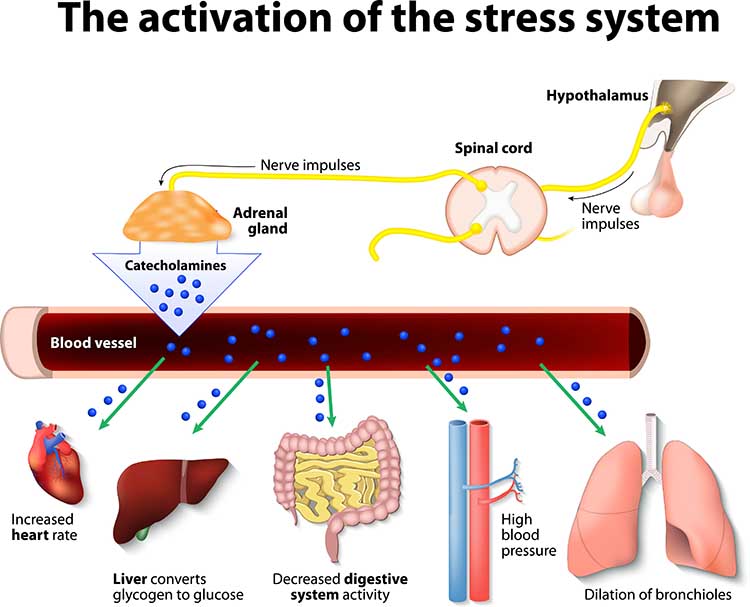
The adrenal medulla releases epinephrine and norepinephrine
in a 4:1 ratio (Fox, 2019). The
adrenal medulla is the inner region of the adrenal glands located at the top of each kidney. Graphic © Designua/Shutterstock.com.
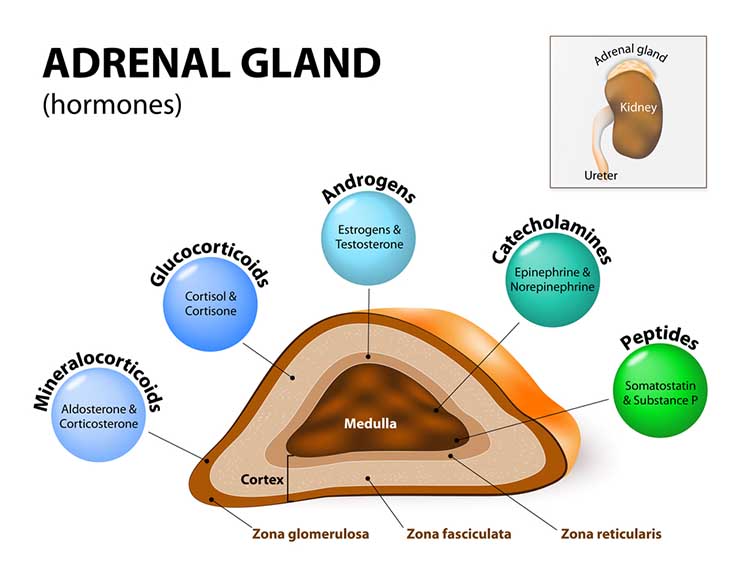
The
catecholamines epinephrine and norepinephrine mobilize blood glucose and fatty acids to provide energy for
skeletal muscle contraction. They increase blood flow to the muscles by increasing
cardiac output and blood pressure. They dilate coronary blood vessels and the bronchioles of the lungs and increase respiratory rate. Increased delivery of oxygen to the brain heightens alertness. As part of fight or flight, they increase metabolic rate, activate
fibrinogen to accelerate clotting, constrict skin blood vessels to reduce blood loss, and release endorphins to suppress pain (McEwen, 2002). Epinephrine levels are higher when we are fearful, and norepinephrine levels are higher when angry (Ward et al., 1983).
SAM activation is adaptive when its intensity and duration enable us to
cope with an external threat. Low SAM activation facilitates athletic and
cognitive performance, while intense SAM activation allows us to overcome
physical threats. However, intense SAM activation is maladaptive in panic attacks or anticipatory anxiety, where there is
neither an external threat nor active coping.
Intense SAM activation can threaten health and produce medical
complaints.

Listen to a mini-lecture on the Effects of Intense SAM Activation © BioSource Software.
Anger can constrict coronary arteries and reduce cardiac output in cardiac patients (Committee on Health and Behavior, 2001) and are a risk factor for heart attacks and sudden cardiac death (Williams et al., 2000). Anxiety and acute grief, which can also produce
intense SAM activation, are risk factors for sudden cardiac death (Engel,
1971; Kawachi et al., 1994). SAM activation also underlies common
symptoms of chest pain, dizziness, and shortness of breath that can be
confused with coronary insufficiency (Crider, 2004).
While Cannon emphasized sympathetic activation,
stressors can also suppress parasympathetic activation and reduce HRV, consisting of changes in the time intervals between consecutive heartbeats (Task
Force, 1996).
Reduced parasympathetic tone can decrease restorative stage 3 sleep, contribute to illness, and increase mortality (Hall et al., 2004).
The Hypothalamic-Pituitary-Adrenal (HPA) Axis
The
hypothalamic-pituitary-adrenal (HPA) axis is the second stage of the
body's defense. The HPA axis is the foundation of allostasis and its failure, allostatic overload (McEwen, 2002). The HPA axis
releases the hormones CRH, ACTH (corticotropin), and cortisol. This
cascade starts with signals from the amygdala to the hypothalamus and
ultimately targets the adrenal glands located at the top of each kidney.

Listen to a mini-lecture on the HPA Axis © BioSource Software.
The
adrenal cortex, which is the adrenal gland's outer region, produces the hormones aldosterone and cortisol. Cortisol is the most important glucocorticoid. Cortisol levels peak from 20-40 minutes following a stressor (Brannon et al., 2022).
This pathway is regulated by
negative feedback as rising cortisol levels inhibit hormone secretion by
the hypothalamus and anterior pituitary. Graphic © Designua/Shutterstock.com.
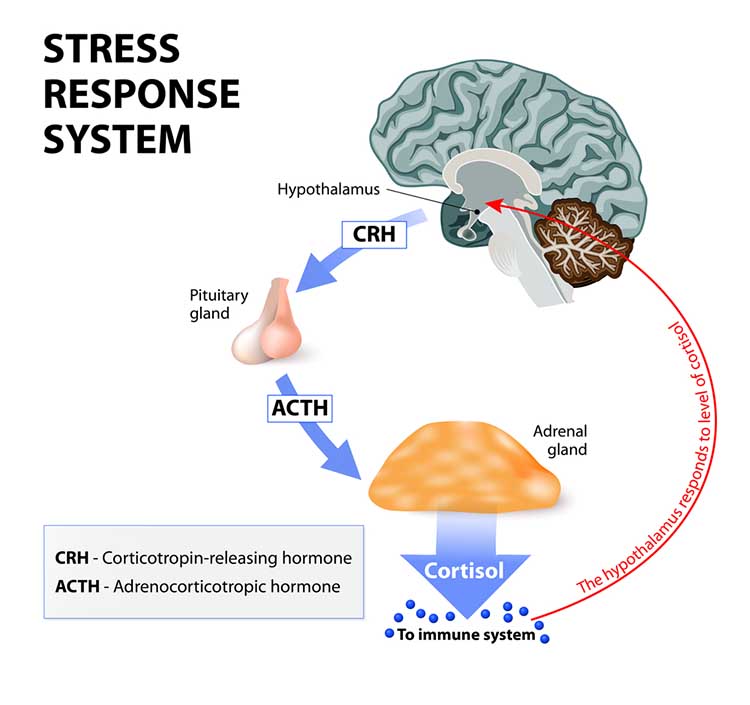
Sustained elevated cortisol levels can affect mood and produce system-wide damage. Graphic © medicalstocks/Shutterstock.com.
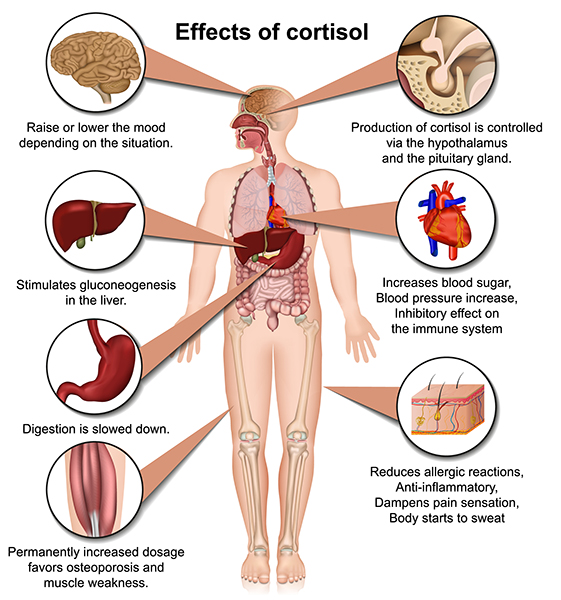
CRH
In
response to stressful stimuli, the
central nucleus of the amygdala activates
the
paraventricular nucleus (PVN) of
the hypothalamus, resulting in increased
CRH release to the
pituitary gland.
Chronic, elevated CRH levels in the bloodstream may enhance learning
classically conditioned fear responses, heighten arousal and attention to increase readiness to respond to a stressor, intensify the startle
response, and reduce appetite and body weight, sexual behavior, and
growth.
ACTH
When CRH
binds to the pituitary gland, it releases
corticotropin (ACTH). ACTH triggers
cortisol release by the
adrenal cortex
(outer part) and helps
resist infection.
Cortisol
Cortisol exerts widespread effects on critical body organs (Kemeny, 2003) and
cortisol levels in the blood index stress, peaking 20 to 40 minutes following a stressor (Brannon et al., 2022).
 Listen to a mini-lecture on Cortisol
Listen to a mini-lecture on Cortisol © BioSource Software LLC.
Cortisol increases our activity and appetite. It helps convert fat and protein to glucose. Cortisol has short-term
and long-term effects on immunity. At first, cortisol directs white blood cells to sites of infection or wounds,
increases their stickiness and adherence to blood vessels and damaged tissue, and communicates when immune
activity is sufficient. Cortisol's long-term effect, however, is impaired immune function (McEwen, 2002).
In healthy individuals, cortisol levels are highest in the early morning, when they help wake us up, and are
lowest at night. In severely depressed individuals, the cortisol rhythm is suppressed, and its levels remain
moderately high over 24 hours. Chronically elevated cortisol
levels in the bloodstream adversely affect many organs, including the
brain.
Allostatic load can result in
hyperglycemia (elevated blood sugar),
insulin insensitivity (prevents insulin from transporting glucose into skeletal
muscles), increased gastric
acid secretion, and ulcer. Muscle protein is converted to fat. Fat storage in the abdomen increases, which
endangers health more than storage in the hips and thighs. Bone mass is reduced due to the loss of minerals (McEwen,
2002).
Cortisol release can affect gene transcription, thus producing
long-term and immediate effects on the body and setting the stage
for several physical and psychological disorders (panic, PTSD, and
somatization).
While we've seen how allostatic load can result in chronically elevated HPA axis release of cortisol, the opposite
pattern, underproduction of cortisol, also occurs. Cortisol suppresses the immune
system, which reduces inflammation and swelling and moderates chronic pain. Low cortisol levels can result in
allergies, asthma, autoimmune disorders like rheumatoid arthritis and multiple sclerosis, and chronic pain
syndromes like fibromyalgia (McEwen, 2002).
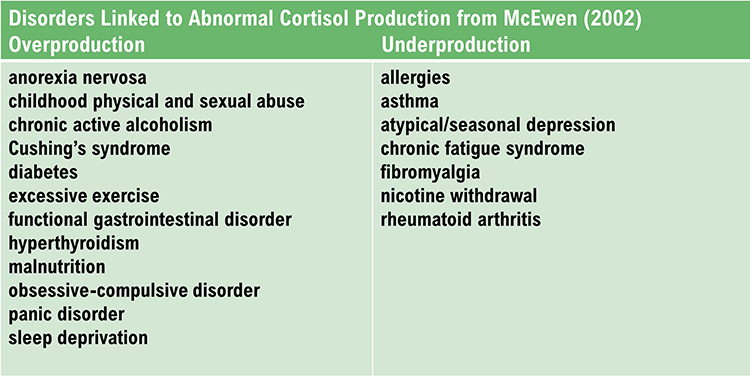
Cortisol binding to the
amygdala increases CRH and ACTH. Cortisol release amplifies the fear response, increases our ability to
store implicit memories about stressful stimuli, and increases the
amygdala’s ability to escape the prefrontal cortex’s regulation of
emotional behavior.
Cortisol binding to the
hippocampal formation disrupts the
medial temporal lobe memory system’s creation of explicit (conscious)
memories. Cortisol interferes with hippocampal regulation of the PVN of the
hypothalamus. Chronically elevated cortisol levels harm and kill hippocampal neurons. Cortisol suppresses neuronal repair by BDNF
and interferes with creating new neurons. The elderly are more vulnerable to cortisol's harmful effects because they shut down their stress response more slowly. Their cortisol negative feedback loop functions less efficiently compared with younger individuals (McEwen, 2002).
Two
pathways from the
raphe system terminate in the
hippocampus: an
anxiogenic anxiety-producing
pathway, and an
anxiolytic, or anxiety-reducing
pathway. Elevated cortisol levels suppress the anxiolytic pathway and
facilitate the anxiogenic pathway. These changes heighten anxiety in a chronically
stressed individual.
Cortisol binding to the
dorsolateral and ventromedial prefrontal cortex injures and kills neurons as in the hippocampus. Cortisol disrupts executive functions like attention and
decision-making, increasing anxiety
and fear.
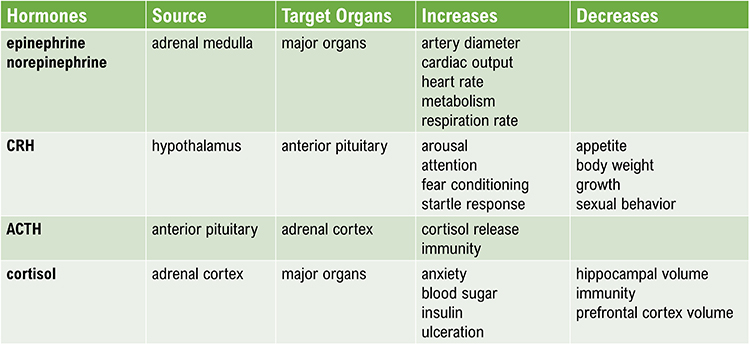
Men and Women Respond Differently to Stressors
Taylor and colleagues argue that men's and women's behavioral and neuroendocrine responses to stressors differ, largely because of oxytocin. The posterior pituitary releases oxytocin when we encounter stressors. Researchers have associated oxytocin, which is affected by estrogen, with social bonding.
Although they share the same nervous system reactions to stressors, men tend to react with fight-or-flight while women respond with tend-and-befriend. Taylor and colleagues (2000) theorize
that a
tend-and-befriend response is
an alternative reaction to stressors. They believe that
tending, nurturing
behavior, and
befriending, seeking, and providing
social support may better characterize women. The tend-and-befriend
response may protect their safety and the lives of their offspring.
Their higher oxytocin levels cause women to seek and provide greater support when distressed than men (Bodenmann et al., 2015; Tamres et al., 2002; Taylor et al., 2000). Supporting this view, women reporting relationship stress have higher blood oxytocin levels (Taylor et al., 2006; Taylor, Saphire-Bernstein, & Seeman, 2010). An interaction may mediate this response between oxytocin and estrogen and endogenous opioids.
Graphic © YAKOBCHUK VIACHESLAV/Shutterstock.com.

Chronic Stress
General Adaptation Syndrome (GAS)
The
General Adaptation Syndrome
(GAS) was
Selye’s (1956) three-stage model of
chronic autonomic and endocrine system responses to stressors.
 Listen to a mini-lecture on the General Adaptation Syndrome
Listen to a mini-lecture on the General Adaptation Syndrome © BioSource Software LLC.
Selye argued that
diverse stressors produce a three-stage response (alarm, resistance, and
exhaustion) in all subjects. In this model, a cold stressor is
interchangeable with a shock stressor because they produce the same
autonomic and endocrine responses. Whereas Cannon showed that acute stress
could change the functions of our internal organs, Selye mainly
demonstrated using animal models that chronic stress can change their
structure (Crider, 2004).
Alarm is the first stage of Selye’s
GAS and consists of shock and countershock
phases. The
shock phase includes
reduced body stress resistance and increased autonomic arousal and
hormone release (ACTH, cortisol, epinephrine, and norepinephrine) that
comprise the fight-or-flight response. In the
countershock phase, resistance increases due to local
defenses.
Resistance is the second stage of
Selye’s General Adaptation Syndrome. Local defenses have made the
generalized stress response unnecessary. Both cortisol output and stress
symptoms, like adrenal gland enlargement, decline. While the person appears to be normal, adaptation to the stressor places mounting demands on the body, leading to diseases of adaptation like hypertension as adaptation energy is depleted. Local defenses will break down if stressors persist. McEwen calls these adjustments allostatic load.
Recovery or Exhaustion is the third stage of
Selye’s General Adaptation Syndrome. We recover when a stressor has ended, and we can restore homeostasis. In exhaustion, increased endocrine activity
depletes body resources and raises
cortisol levels, resulting in suppressed immunity and stress syndrome
symptoms. Selye believed that these changes could
cripple immunity and cause bronchial asthma, cardiovascular
disease, depression, hypertension, hyperthyroidism, peptic ulcer, ulcerative colitis, and possibly death (Brannon et al., 2022).
While Selye conceptualized stress as the outcome of the three-stage GAS, stress may occur at any time. Individuals may experience stress-related changes in anticipation of an event or after it has ended. Chronic resistance appears to produce more significant harm than exhaustion (Taylor, 2021).
Graphic adapted from Biostrap.
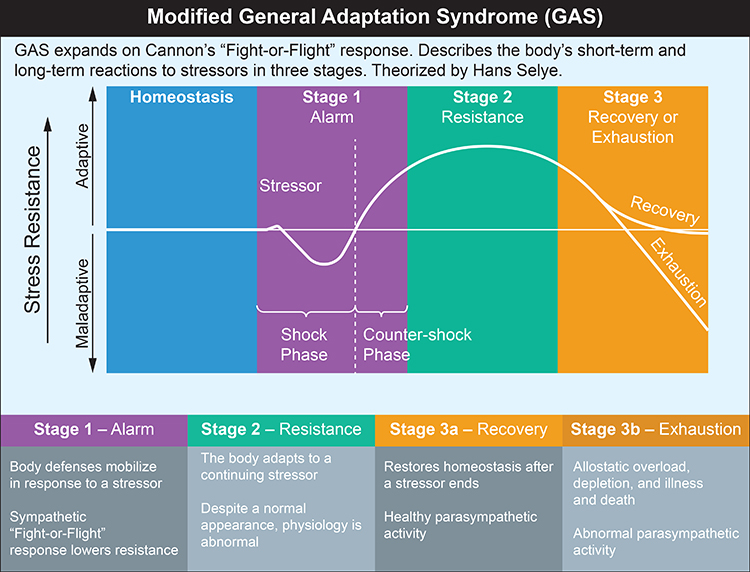
While Selye made a landmark contribution to our understanding of the role
of chronic stress and glucocorticoid-mediated damage in disease, critics
have challenged his characterization of the stress response as
nonspecific and his conceptualization of stressors. Critics have questioned the GAS on
four issues.
First,
since most of Selye's research subjects were nonhuman animals,
this may
have caused him to essentially overlook the role of human emotion and
cognitive appraisal in the chronic stress response.
Second, since Selye focused on stressors instead of human characteristics like biological predispositions and
personality, he mistakenly assumed a uniform response to stressors. Stressors can produce
different hormonal responses (Kemeny, 2003).
Third, while Selye emphasized the role of exhaustion in disease, there is more substantial evidence that chronic resistance
may produce more significant harm (Taylor, 2012).
Fourth, while Selye conceptualized stress as the outcome of the GAS, both the anticipation
of an event and coping with it during the resistance stage can disrupt performance and produce suffering (Taylor,
2012).
Brain Structures Involved in Stress
The amygdala, hypothalamus, hippocampus, and prefrontal cortex are the four brain structures most important to the stress response.
The
amygdala is part of the limbic
system and participates in evaluating whether stimuli are threatening,
establishing unconscious emotional memories, learning conditioned
emotional responses, and producing anxiety and fear responses. The animation below is courtesy of Wikipedia.
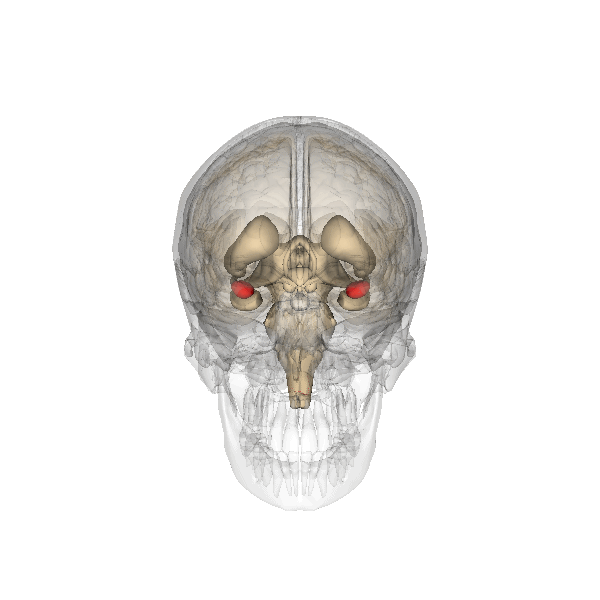
The
hypothalamus lies
beneath the thalamus in the forebrain. It helps the body maintain a
dynamic homeostatic balance by controlling the autonomic nervous
system, endocrine system, survival behaviors (four F’s), and
interconnections with the immune system. The animation below is courtesy of Wikipedia.
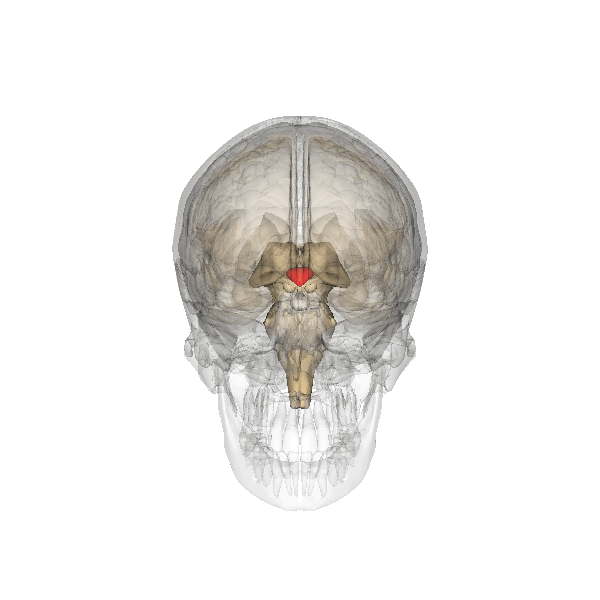
The Hypothalamus Receives Information About Stressors
Much of the information about stressors is relayed to the PVN. This hypothalamic nucleus organizes behavior to respond
to changes in internal body states. The PVN receives
input from the limbic system and cerebral cortex, other parts of the hypothalamus, and brainstem structures (nucleus of the solitary tract,
tegmentum and
reticular formation, periaqueductal gray, locus coeruleus, and raphe
system).
Graphic © Alila Medical Media/Shutterstock.com.
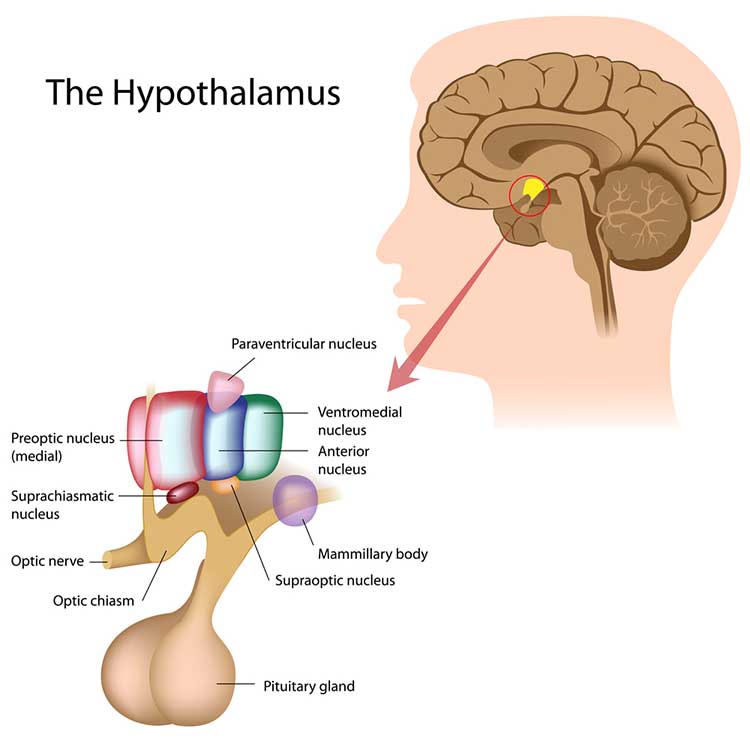
When the PVN is excited, it releases several
chemical substances, including CRH,
oxytocin, arginine-vasopressin, thyrotropin-releasing hormone, growth
hormone-releasing hormone, somatostatin, dopamine, enkephalin,
cholecystokinin, and angiotensin.
This large variety of hormones
enables the individual to respond to a wide range of stressors. Since
stressful events may simultaneously present many stressors, these chemical substances allow the individual to respond
completely and appropriately.
The
hippocampus is part of the medial temporal lobe memory system
and helps form declarative memories, allows us to navigate our
environment, and prevents excessive hypothalamic CRH release. Graphic © decade3d - anatomy online/Shutterstock.com.
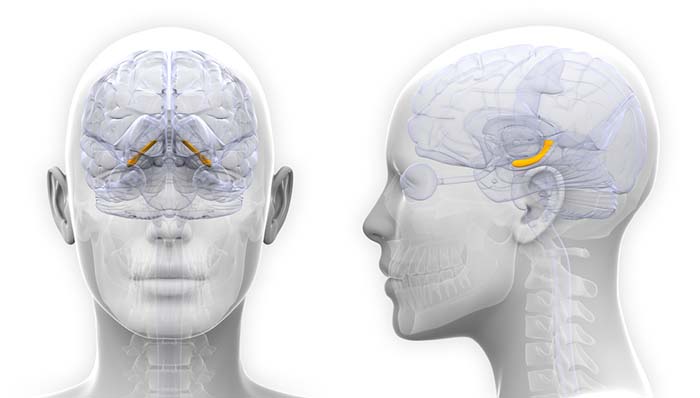
The
prefrontal cortex (PFC) is the most anterior region of the frontal lobes. The PFC contains the orbitofrontal and ventromedial, dorsolateral prefrontal cortex, and anterior and ventral cingulate
cortex. The PFC is responsible
for the brain’s executive functions, including planning, guiding
decisions using emotional intelligence, working memory, allocation of
attention, and emotional experience. The PFC inhibits emotional behavior
triggered by the amygdala. Graphic
©
2003 by Josephine F. Wilson.
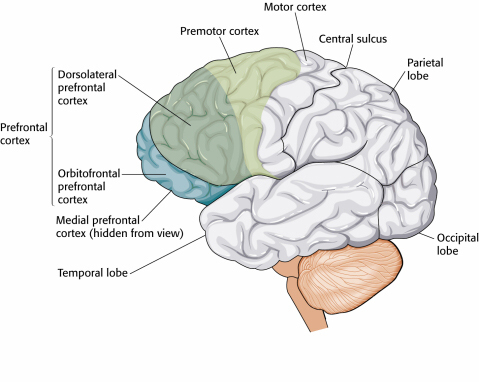
Psychoneuroimmunology (PNI)
Nonspecific and Specific Immune Mechanisms
The human body utilizes nonspecific and specific immune mechanisms to protect itself against invading organisms, damaged cells, and cancer.
The main nonspecific, or innate, mechanisms are relatively rapid in response and include anatomical barriers (skin and mucous membranes) and phagocytosis (ingestion of microorganisms) by macrophages and neutrophils. Natural killer cells and neutrophils destroy infectious agents. Nonspecific mechanisms release antimicrobial agents (hydrochloric acid, interferons, and lysozymes) and signal to other immune responders. Local inflammatory responses confine microbes, allowing white blood cells and other immune cells to attack them.
In contrast, specific or adaptive immune mechanisms are slower and aim to target invaders and diseased cells selectively. The specific immune response involves the production and proliferation of antibodies by B cells, targeted destruction of foreign material by T cells, and preparation for future infiltrations of the same antigen (Shaffer & Mannion, 2016). In the illustration below, macrophages arrive to protect endangered cells. Graphic © UGREEN 3S/Shutterstock.com.
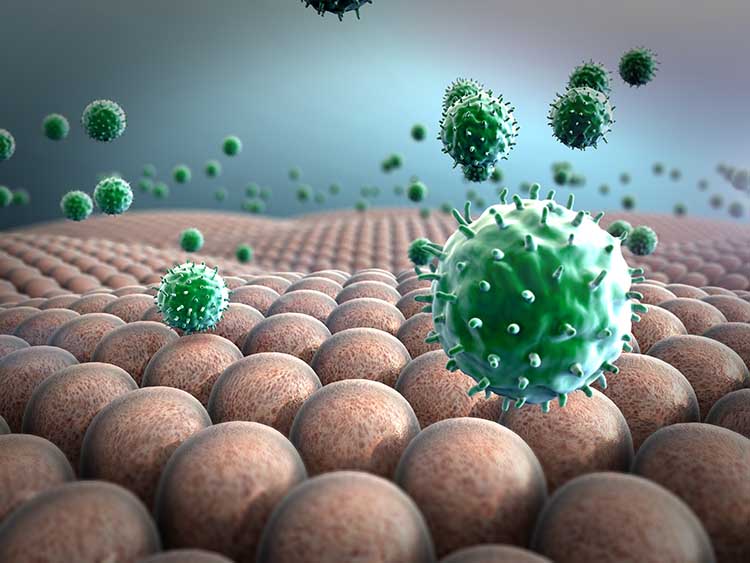
We develop
specific immunity after
birth through exposure to microorganisms and vaccinations, and it
employs an
antigen-antibody reaction
to protect us against specific microorganisms and their toxins.
Antigens are foreign molecules (proteins or polysaccharides) that
stimulate antibody production.
Antibodies
are cellular proteins that combine with antigens to neutralize them.
Humoral and cell-mediated immunity are two types of specific immune
responses. In
humoral immunity,
B lymphocytes rapidly produce antibodies that counter bacteria into the blood, neutralize
toxins, and prevent reinfection by viruses. The illustration below shows lymphocytes (white) attacking bacteria. Graphic © dreamerb/Shutterstock.com.
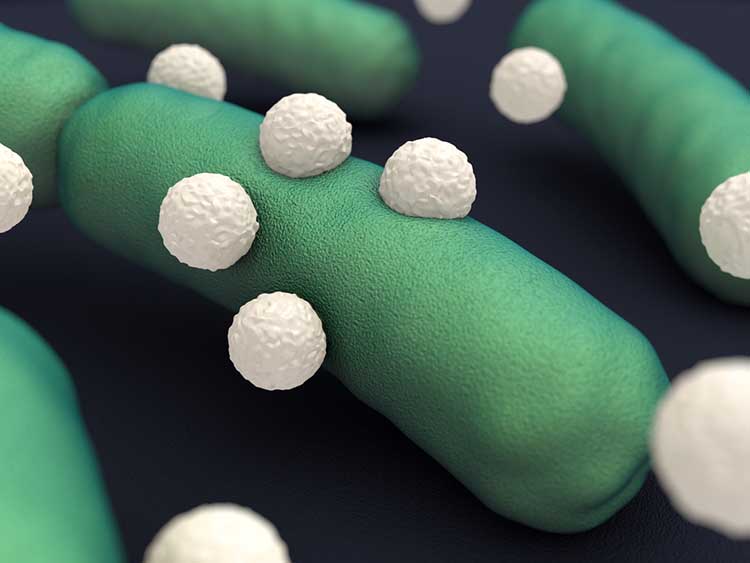
Activated B cells
differentiate into
plasma cells,
which secrete antibodies (immunoglobulins), and
memory B cells, which are transformed into
antigen-specific plasma cells when they reencounter the original
antigen. Humoral immunity is most effective in countering bacterial
infections and preventing new viral infections. The illustration below shows lymphocytes (white) attacking bacteria. Graphic © Designua/Shutterstock.com.
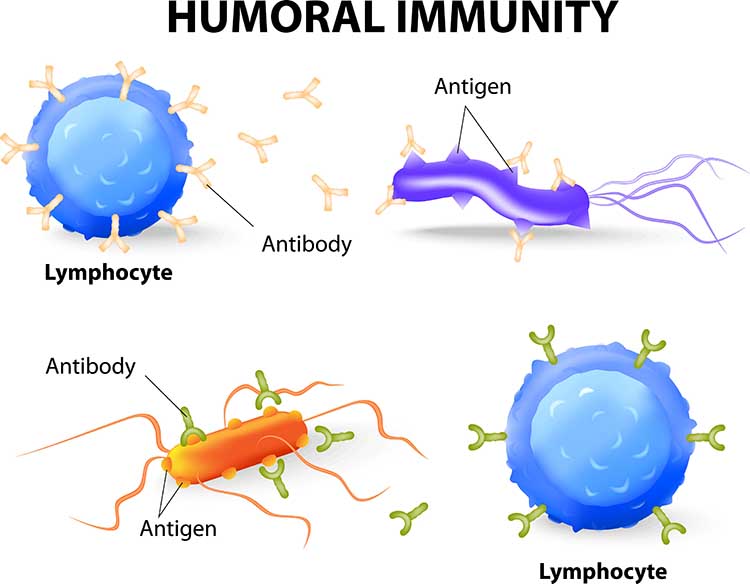
Cell-mediated immunity provides a
slower cellular response that utilizes cytotoxic and helper T cells
from T lymphocytes provided by the thymus gland.
Cytotoxic T (TC)
cells release toxins to destroy specific virally infected
cells.
Helper T (TH)
cells release cytokines like interleukin-2 to aid T
C and B cells' action and macrophages. T
H cell
cytokines can also suppress immune responses. Cell-mediated
immunity is most effective in controlling cancer, foreign tissue, fungal
and viral infections, and parasites.
Two-Way Brain-Immune System Communication
Nervous and immune system communication is bidirectional. From the nervous system side, adrenal cortical release of glucocorticoids suppresses immunity, including cell-mediated mechanisms like phagocytosis. At the start of the COVID-19 pandemic, admitted patients with higher cortisol levels were more likely to die from this infection (Tan et al., 2020).
From the immune system side, increased proinflammatory cytokine release can signal the nervous system, resulting in feelings of depression, fatigue, loss of energy, and reduced pleasure (Anisman et al., 2005; Brannon et al., 2022; Dantzer et al., 2008). Acute and prolonged brain fog due to COVID-19 has been attributed to elevated cytokine levels (Theoharides et al., 2021). Graphic © Designua/Shutterstock.com.
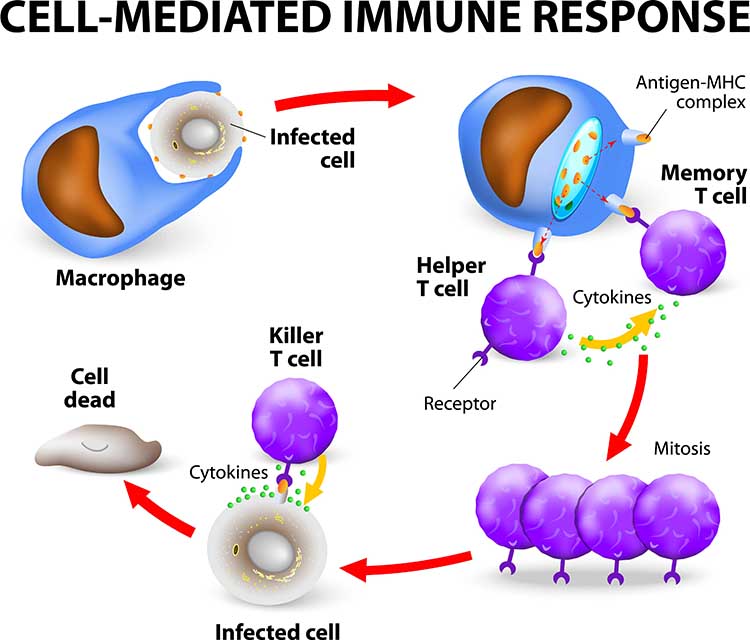
Check out Professor Gillian Griffiths' video
Killer T Cell: The Cancer Assassin.
The Immune System Is Interconnected with the Nervous System
The classical model of the immune system is that it operates
independently of the nervous system and psychological processes.
However, researchers have demonstrated complex interactions among the nervous, endocrine, and immune systems, consistent with Green and Green's psychophysiological principle. Psychological
processes like expectancies (placebo effect) and learning (classical
conditioning) can affect all three systems, and the immune system can
affect psychological functioning (drowsiness from a fever).
Psychoneuroimmunology is a
multidisciplinary field that studies the interactions between behavior
and these three systems.
After Solomon and Moos (1964)
introduced the term psychoneuroimmunology in a journal article,
Ader and Cohen's (1975) demonstration of classical conditioning in a rat's
immune system helped
establish this field's scientific legitimacy.
Ader and Cohen trained
rats to associate a
conditioned stimulus
(a
saccharine and water solution)
with an
unconditioned stimulus (the
immunosuppressive drug cyclophosphamide). This resulted in a
conditioned response (CR) of immune
suppression, which resulted in rat fatalities. Following conditioning,
rats who drank only sweetened water (CS) died due to
conditioned immunosuppression.
Successful replication of these findings helped overcome resistance to
the controversial view that the nervous system and immune system can
interact.
The mechanisms underlying these complex interactions include
HPA axis hormones (ACTH, cortisol,
CRH, epinephrine, and norepinephrine), immune cell chemical messengers
called
cytokines (interleukins),
additional hormones (androgens, estrogens, progesterone, and growth hormone),
and neuropeptides.
Neuropeptides are chains of amino acids, like
beta-endorphins, that neurons use for communication.
Stress and Immunity
There is persuasive evidence that stressful life events can reduce
immunity and that behavioral interventions can enhance or maintain it.
Bereavement can reduce lymphocyte (lymphatic white blood cell)
proliferation (Schleifer et al., 1983). Academic exams, marital
conflict, negative affect associated with stress, clinical and
subclinical depression, and negative daily mood can suppress immunity
(Herbert & Cohen, 1993; Kiecolt-Glaser et al., 2002; Stone et al.,
1994).
The stress of living near the Three Mile Island nuclear plant when it
experienced a significant accident reduced residents' B cell, T cell, and
natural killer cell counts compared with control subjects (McKinnon
et al., 1989).
A study of Alzheimer's caregivers showed lowered immunity and longer
wound healing times, and worse psychological and physical health than
controls who were not caregivers (Kiecolt-Glaser, 1999). The
Alzheimer's patients' deaths did not improve caregiver immunity or
psychological functioning (Robinson-Whelen et al., 2001).
Finally, laboratory stressors produced more significant discomfort and
immunosuppression in chronically-stressed young males than those not chronically stressed (Pike et al., 1994). Exposure to chronic
stress may have intensified their subjects' response to acute laboratory
stressors.
Behavioral Interventions Can Strengthen Immunity
Behavioral interventions can increase immunocompetence. Miller and Cohen's (2001)
meta-analytical study of behavioral interventions showed modest
increases in immunity. Hypnosis increased immune function more than
relaxation and stress management.
A stress management program that incorporated relaxation training
reduced symptoms and increased salivary antibodies and psychological
functioning in children diagnosed with frequent upper respiratory
infections (Hewson-Bower & Drummond, 2001).
College students who wrote journal entries about highly stressful
experiences increased lymphocyte proliferation and made fewer health
center visits (Pennebaker et al., 1988). Smyth et al.
(1999) asked asthma and
rheumatoid arthritis patients to write journal entries about highly
stressful experiences or planned daily activities. At a 4-month
follow-up, 50% of the Pennebaker journal group who wrote about stressful
experiences and 25% of the control group achieved clinically significant
improvement in their immune-related disorders (Crider, 2004).
Dental and medical students who received hypnosis training maintained
immune function while a control group showed declines in immunity (Kiecolt-Glaser
et al., 2001). This finding suggests that behavioral interventions may be more
effective in maintaining normal immunity than boosting immunity (Brannon et al., 2022).
Cognitive Appraisal of Stressors and Coping
Lazarus and Folkman's (1984)
Transactional
Model of Stress has more strongly influenced psychologists
than Selye's General Adaptation Syndrome.
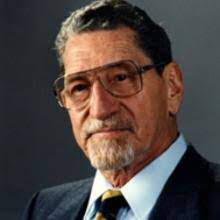
Caption: Richard Lazarus
Whereas Selye's stimulus model theorized that events determine stress, Lazarus' cognitive model proposed that stress is determined by our perception of the situation and emphasizes person-environment
fit (Taylor, 2012).
Coping is central to the Transactional Model of Stress. Lazarus and Folkman defined it as "constantly changing cognitive and behavioral efforts to manage specific external and/or internal demands that are appraised as taxing or exceeding the resources of the person” (1984, p. 141). Coping is an effortful learned process whose goal is to manage a situation (Brannon et al., 2022).

Listen to a mini-lecture on the Transactional Model of Stress © BioSource Software LLC.
In
primary appraisal, we categorize the consequences of events as positive, neutral, or negative and determine whether an event is relevant, negative, or potentially negative. We evaluate these events for their possible harm, threat, or
challenge.
Harm is damage that has
already occurred. For example, a person who experiences a heart attack
may perceive harm as damage to the heart muscle.
Threat means damage that could arise in the future. The
heart attack survivor may anticipate restricted physical activity and
reduced income. The perception of an event as a threat has physiological
consequences and can result in elevated blood pressure.
Challenge is the potential to cope
with the event and gain from this opportunity. The heart attack survivor
may reframe this health crisis as an opportunity to make a career
change. The perception of an event as a challenge can increase perceived
self-efficacy and positive emotion while lowering blood pressure (Maier et al.,
2003).
The Chinese pictogram
wei ji,
representing danger and opportunity, illustrates the negative and
positive possibilities considered during primary appraisal.

During
secondary appraisal, we evaluate whether our coping abilities and resources can surmount an event's harm, threat, or challenge. Lazarus and
Folkman (1984) listed health and energy, positive belief,
problem-solving skills, social skills, social support, and material
resources as necessary coping resources. Again, perception of our coping
abilities and resources is more important than their actual existence.
The balance between primary and secondary appraisal determines how we
subjectively experience the event. We experience the most stress when
perceived harm or threat is high and perceived coping skills and
resources are low. Stress is reduced when we perceive that our coping
abilities and resources are high (Taylor, 2012).
Secondary appraisal can lead to our use of direct action, reappraisal,
and palliation.
Direct action can take different
forms depending on the nature of the threat. We may use aggression and escape behaviors from Cannon's fight-or-flight response for violent threats to our survival. We may use problem-solving for medical or psychological threats, define the problem, identify options, and test these options until we succeed. A cardiac patient may enroll
in a cardiac rehabilitation program to increase exercise tolerance and
reduce the risk of artery narrowing.
Reappraisal may reduce stress when
direct action is impractical or unsuccessful. Reappraisal modifies our
perception of a threat. When individuals are overwhelmed by traumatic
stress, they may initially use ineffective strategies like denial and
rationalization. As they cope with the crisis, they may progress with
more successful strategies like
reframing
in which they place the stressful situation in perspective and focus on
available opportunities. For example, a cardiac patient may decide that his heart
attack allowed him to spend more time with his
grandchildren.
Palliation consists of efforts to
reduce our stress response rather than attack the stressor. Clinicians
may use biofeedback and adjunctive techniques like effortless breathing
to teach cardiac patients to control their anxiety. While this does not
correct the cause of the stress response, it is often superior to
medications like anxiolytics that risk side effects, tolerance, physical
dependence, and withdrawal effects. Successful clinical interventions
for chronic problems like anxiety, depression, and pain incorporate
effective palliation since complete remission may be unlikely. The diagram below was adapted from Crider
(2004).
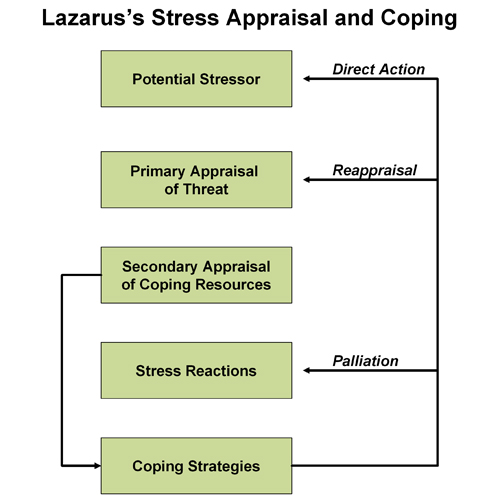
Evaluation
The Transactional Model of Stress encompasses cognitive appraisal, missing from the General Adaptation Syndrome. Research supports this model. For example, performance is better when we perceive an event as challenging instead of threatening (Moore et al., 2012).
Lazarus and Folkman's model recognizes that we constantly change as we cope with stressors and that our coping successes and failures influence our appraisals of future events (Brannon et al., 2022).
Perception of Stressors Impacts Health
Cannon (1942) studied voodoo deaths in shamanistic cultures and published speculation about how beliefs can produce lethal cascades of system failure in the
American Anthropologist. Graphic © Fer Gregory/Shutterstock.com.
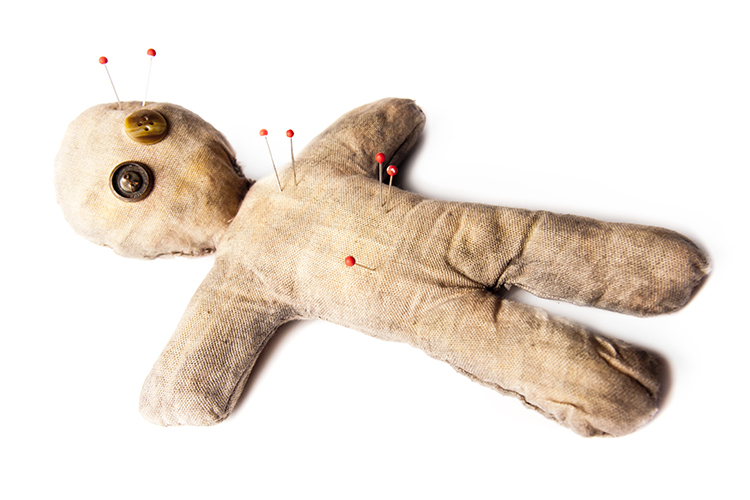
Keller et al. (2012) conducted a regression analysis of the 1998 National Health Interview Survey and prospective National Death Index data from 28,753 adults. Both elevated levels of reported stress and the perception that stress negatively impacted health independently and jointly predicted poor physical and psychological health outcomes. While neither variable independently predicted premature death, subjects who reported high levels of stress and the perception that stress impacts health experienced a 43% greater risk of early death.
 Listen to a mini-lecture on the Effect of the Perception That Stress Harms Health
Listen to a mini-lecture on the Effect of the Perception That Stress Harms Health © BioSource Software LLC.
Check out Kelly McGonigal's TED Talk
How to Make Stress Your Friend.
McGonigal proposes that we train clients to reframe sympathetic activation as evidence of our courage to rise to a challenge instead of the body injuring itself.

Real Genius was drawn by Dani S@unclebelang.
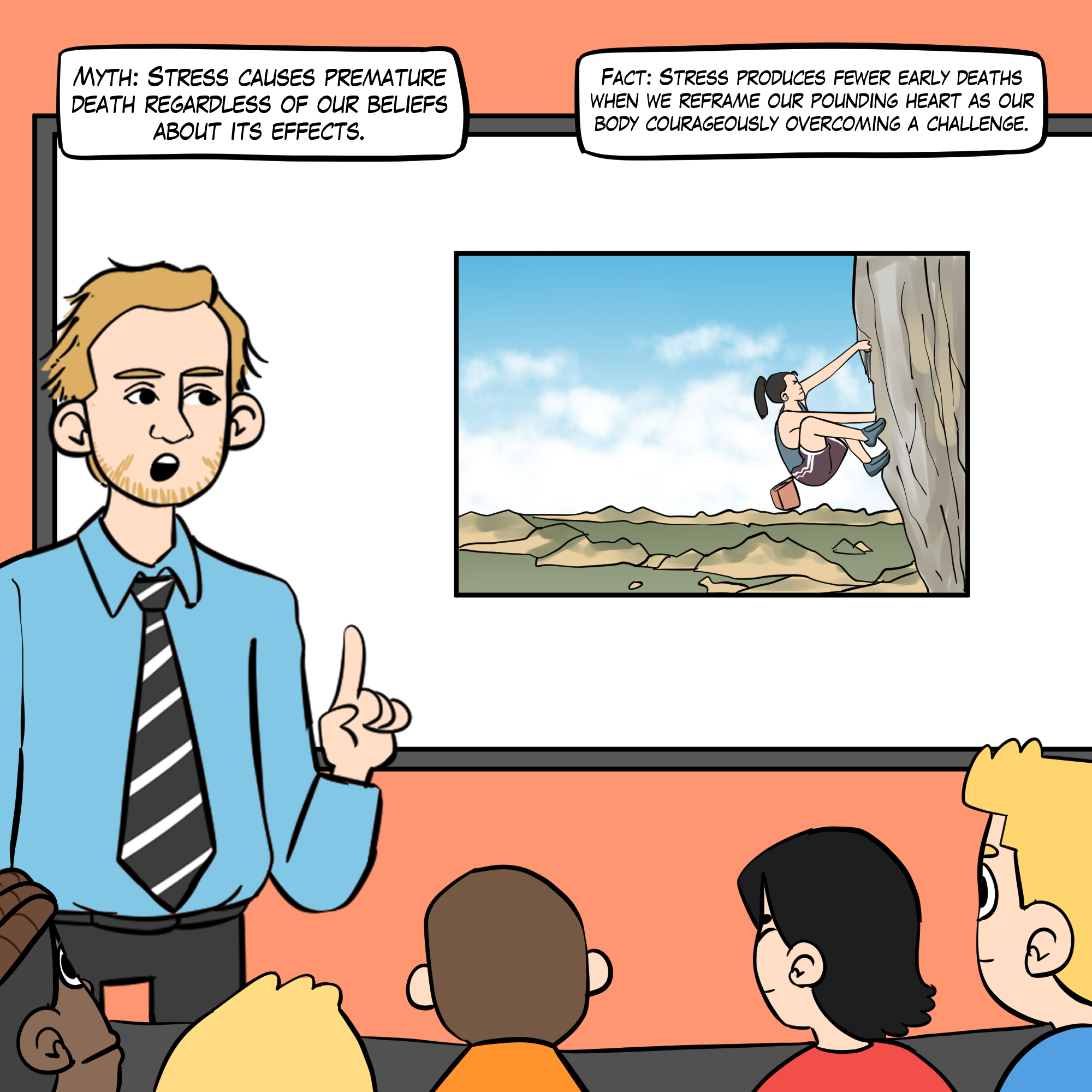
Personality Dimensions
The personality dimensions of mastery, impulsiveness, hopelessness, optimism, and pessimism, and constructs like alexithymia and reactivity are important to understanding stress responses.
Mastery
Mastery overlaps with the
concepts of
locus of control,
perceived control, and
self-efficacy. Mastery is the
relatively stable expectancy that we can control personal outcomes. Graphic © pamspix/iStockphoto.com.
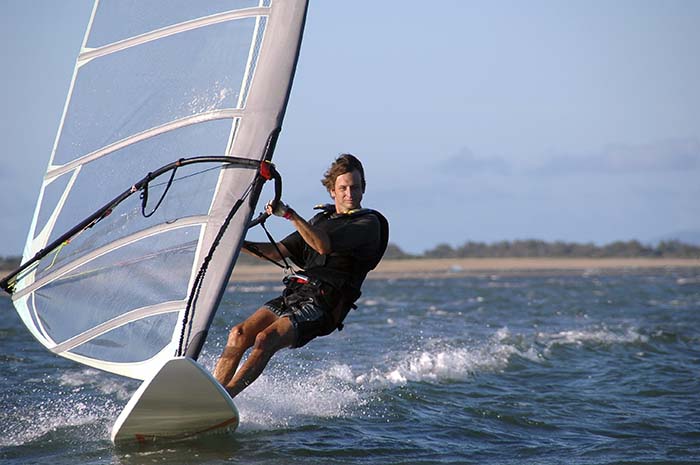
Mastery affects our appraisal and coping with stressors. Individuals
with high levels of mastery expect to succeed when challenged by
stressors, cope more effectively, and report lower levels of depression
and stress than people with low levels of mastery (Gurung, 2019).
In Weiss’ (1977) replication of the
Brady “executive monkey” study, the "executive” rat could switch off the
tail shock by turning the wheel. Because it had control over the shock,
it was no more likely to develop ulcers than an unshocked control rat.
The "subordinate" rat received the same shocks as the "executive" rat.
Because the "subordinate" rat had no control over the shocks, it was
more likely to develop ulcers than the "executive" rat.
Impulsiveness
Distress can increase impulsive behavior that produces immediate relief or pleasure, sometimes at the cost of
personal health (Tice et al., 2001). Graphic © YouraPechkin/iStockphoto.com.

Examples include binge drinking, suspending medication and physical exercise, consuming unhealthy meals, and
defaulting on responsibilities like attending class or work. Substance abuse may reduce an individuals' motivation
and capacity to meet their commitments.
Hopelessness
Hopelessness is a depressive symptom that might be an independent heart attack
risk
factor. Compared with middle-aged Finnish men scoring low in
hopelessness, those scoring high were two to three times more vulnerable
to a heart attack over the ensuing 6 years and three to four times
more likely to die (Everson et al., 1996). Graphic © microcosmos/Shutterstock.

Optimism
Optimism is a generalized expectancy
of positive future outcomes. Optimists focus on a situation's positive
dimensions, minimizing daily hassles (Nelson et al., 1995). Graphic © hidesy/iStockphoto.com.

Optimism aids health by encouraging more effective
problem-focused coping strategies instead of
avoidant coping strategies. These strategies result in better stress management and practice of health-promoting
behaviors like barrier protection during sex. Optimists show good
psychological health, effective natural killer (NK) cell response during
stress, and slower AIDS progression. In the context of the Transactional Model of Stress, optimists diverge from pessimists in secondary appraisal, actions, and personal adjustment (Gurung, 2019).
A prospective study showed that the 25 percent most optimistic women had about a 30 percent lower mortality risk than the 25 percent least optimistic women. Dispositional optimism was associated with reduced mortality due to cancer, heart disease, infection, respiratory disease, and stroke. While attenuated, these results held up after controlling socioeconomic status, depression, health conditions, and health-related behaviors (Kim et al., 2016).
Pessimism
Pessimism, a generalized expectancy of future adverse outcomes, is
also a heart attack
risk factor. A Harvard School of Public Health team found pessimistic
adult men had a doubled risk of developing heart disease over 10 years (Kubzansky et al., 2001). Pessimism graphic © Billion Photos/shutterstock.com.

Alexithymia
Wickramasekera (1988) described
alexithymics as low in hypnotic ability and awareness of internal cues and feelings associated with illness. Alexithymia is prevalent in patients with multiple psychosomatic complaints and may delay seeking and receiving medical attention.
Reactivity
Eliot's (1992)
hot reactors cannot be identified by
their overt behavior but risk sudden death due to pathological acute
and chronic responses to stressors. Hot reactors show an acute increase
in catecholamine secretion, which increases the risk of cardiac
arrhythmia due to excessive myocardial fiber contraction and clot
formation. When they are challenged by long-term stressors and
experience fear, uncertainty, and loss of control, they also show a
chronic increase in glucocorticoid secretion, which raises total
cholesterol while lowering protective HDL-C.
African Americans start to show greater reactivity than their European American counterparts by childhood (Murphy et al., 1995), perhaps due to stressors associated with their ethnicity. This difference
may help explain their higher prevalence of cardiovascular disease.
Everson et al. (2001) discovered that the risk of stroke was more significant for men with
higher systolic blood pressure reactivity.
Resources to Buffer Stress
Social Support
Social support consists of
received support (support
provided) and
perceived support
(expected support) from individuals and organizations. Both forms of social support include informational,
material, and psychological assistance from others. The value of each
kind of social support depends on an individual's specific needs. Graphic © Yuri/iStockphoto.com.

Social networks and social contacts
both concern the number and kinds of interpersonal relationships. A
social network is a social structure consisting of nodes (individuals or organizations)
tied together.
Social contacts are the nodes (individuals or organizations)
comprising a person’s social network.
Patients with a high level of social support
participate in an extensive social network consisting of numerous social
contacts. Those with low social support have a limited social network
with few social connections.
High levels of social support are associated with better health, faster
recuperation, less psychological distress, lower depression risk, and
lower mortality than low levels of social support (Gurung, 2019). Graphic © Ljupco Smokovski/Shutterstock.com.

The
Alameda County Study (Berkman &
Syme, 1979) documented a relationship between social contacts
and longevity. Adults with the fewest social connections had 2-4 times the
risk of death than those with the most social contacts. Gender and age
moderated the effect of social connection. Males' highest relative risk of
death (3.2) was from age 50-59, whereas women's highest relative risk
(4.6) was from age 30-49 (Brannon et al., 2022).
 Listen to a mini-lecture on the importance of social contact
Listen to a mini-lecture on the importance of social contact © BioSource Software LLC. Graphic © Ljupco Smokovski/Shutterstock.com.
 Hawkley and colleagues
Hawkley and colleagues (2006) reported that loneliness is an independent risk
factor for hypertension comparable to obesity and a sedentary lifestyle. They studied 229 participants aged
50 to 68 years and measured their perceived degree of loneliness, as well as previously established cardiovascular
and psychosocial risk factors. Even after statistically controlling for other negative
emotional states (e.g., depression, hostility, or stress), lonely older participants had systolic blood pressures
up to 30 mmHg higher than their non-lonely counterparts. They discovered that loneliness and stress
raised blood pressure via different mechanisms and produced an additive effect. Furthermore, the impact
of loneliness on blood pressure increased with age.
Prosocial Behavior
A prospective study of 846 adults by Poulin et al. (2013) showed that providing tangible assistance to friends or family members in the previous year buffered the effects of stress on mortality over 5 years. In contrast, stress predicted mortality for participants who did not help others. Real Genius was drawn by Dani S@unclebelang.
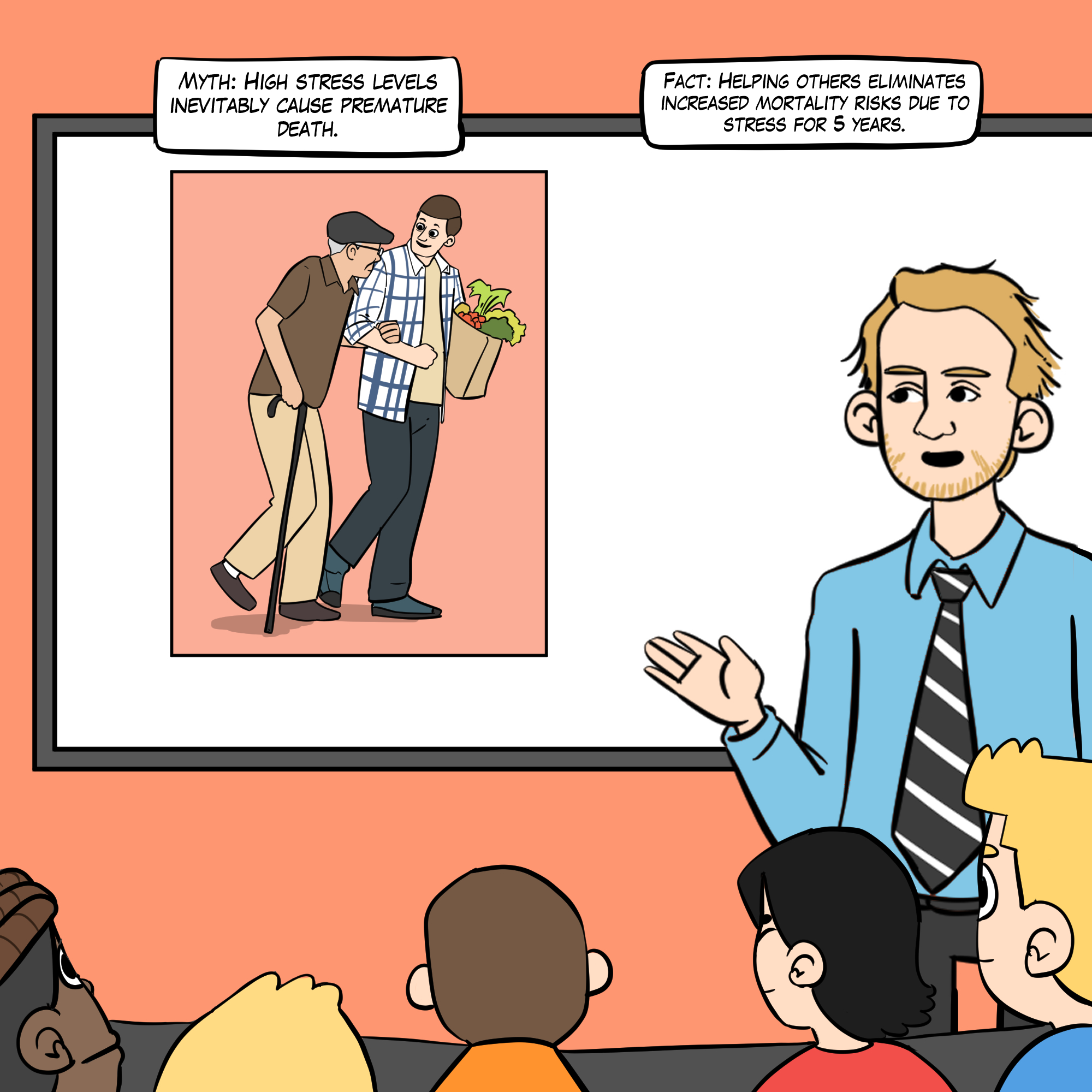
Follow-up data from the longitudinal National Survey of Midlife Development in the U.S. (MIDUS II) of 1054 middle-aged adults found that women who perceived that they supported others in positive social relationships had lower IL-6 levels, a marker for inflammation (Jiang et al., 2021). Elevated IL-6 levels are linked to an increased risk for serious diseases.
 Listen to a mini-lecture on the importance of prosocial behavior
Listen to a mini-lecture on the importance of prosocial behavior © BioSource Software LLC.
Graphic © Monkey Business img/Shutterstock.com.

Aerobic Exercise
A sedentary lifestyle marked by prolonged sitting and TV-viewing time was linked to chronic health conditions and all-cause mortality in a meta-analysis of data from over 1 million middle-aged men and women. Individuals who engaged in moderate-intensity exercise 60-75 minutes per day eliminated the increased risk of death due to sitting but only attenuated the risk associated with TV-viewing time (Ekelund et al., 2016). Graphic © racornShutterstock.com.

Mildly depressed college women who participated in an aerobic exercise
program showed markedly reduced depression compared with those who did
relaxation exercises or received no treatment (McCann & Holmes, 1984). Graphic © Maksim Toome/Shutterstock.com.

A study that compared exercise with drug treatment or a combination of
exercise and drug treatment found that exercise improved mood and
the other two conditions. When treatment was discontinued, participants
who continued to exercise were less likely to relapse than those who had
received drug treatment (Babyak et al., 2000).
The positive impact of exercise on mood may be mediated by reduced
cardiovascular reactivity (Perkins et al., 1986), and increased involvement (Estabrooks
& Carron, 1999), self-efficacy (McAuley et al., 2003),
and self-esteem (Sonstroem, 1997). Graphic © OSTILL is Franck Camhi/shutterstock.com.
.jpg)
Religious and Spiritual Activity
In a national health survey financed by the U.S. Centers for Disease
Control and Prevention, religiously active people had longer life
expectancies (Hummer et al., 1999). McCullough
and colleagues (2000) performed a meta-analysis that assigned
greater weights to studies that controlled confounding variables like
age, gender, health, and social support. They found that religious
involvement was linked to a slightly lower mortality rate and that
this was not due to social support. Graphic © LincolnRogers/ iStockphoto.com.

BASIC PHYSIOLOGY OF ATTENTION
Brain Organization and Dynamics
The brain is organized into interactive functional distributed networks with spatial, temporal, and content-based relationships.
These networks interact through feedback loops and transiently organized aggregates of neurons, all mediated by rhythmic, oscillatory electrical discharges that ultimately produce the EEG.
This process is further controlled/informed by selective attention to specific categories of interest.
Graphic uploaded to ResearchGate by Maurizio Corbetta from the The dynamical balance of the brain at rest.
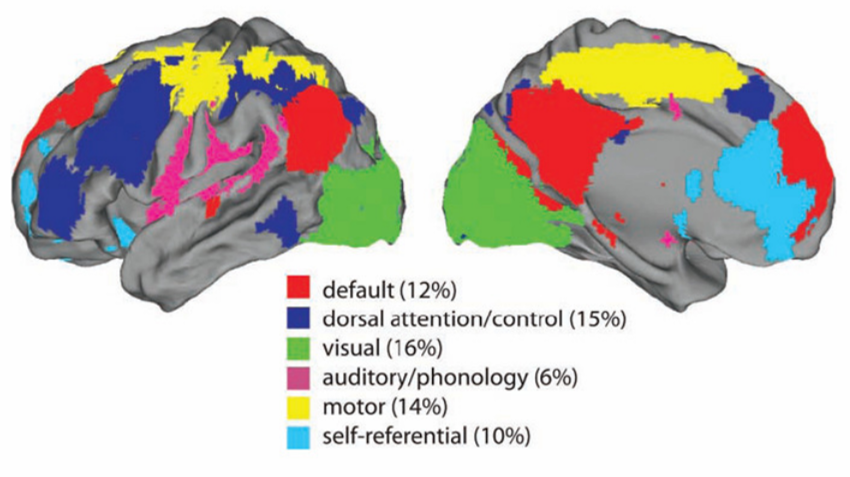
Each type of local cognitive, sensory processing, or emotional network produces oscillatory activity and contains internal stabilizing characteristics. These local networks exist within a global dynamic network
system that links and provides an interactive capacity to the smaller networks, also operating within an oscillatory framework.
The central nervous system processes incoming content. Separate regions process specialized content (e.g., auditory, kinesthetic, tactile, visual). Content is shared, integrated, compared to previous content, and analyzed. Decisions are made regarding memory and responses. All of this central nervous system activity occurs within interacting networks linked by electrical/chemical signals. Electrical discharges from network activity are recorded from the scalp surface as the EEG.
Network Overview
The networks most relevant to attention include the executive, affective, motor, oculomotor, and social circuits.
Executive Network
The dorsolateral prefrontal cortex plays a critical role in executive functions, which Kropotov (2009) described as "the coordination and control of motor and cognitive actions to attain specific goals." Executive functions include allocation of attention, cognitive inhibition, behavioral inhibition, working memory, and cognitive flexibility. The executive network focuses and maintains continuous attention. The diagrams below were adapted from Alexander et al. (1986) and Thompson and Thompson (2016).
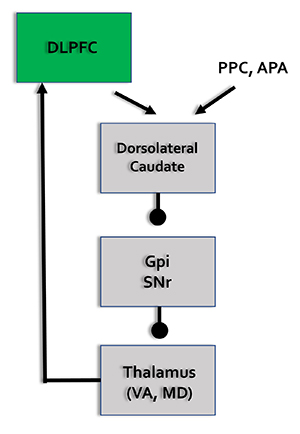
DLPC = dorsolateral prefrontal cortex, PPC = posterior parietal cortex, APA = arcuate premotor area, GPi = globus pallidus internal segment, SNr = substantia nigra, pars reticulata, VA = ventral anterior nucleus of the thalamus, MD = medial dorsal nucleus of the thalamus.
Affective Network
The pre- and subgenual areas of the
anterior cingulate cortex (ACC) participate in affective circuits triggered when we make mistakes. The dorsal rostral cingulate zone monitors cognitive activity to predict when errors are likely, and greater executive control may be needed (Thompson & Thompson, 2016).
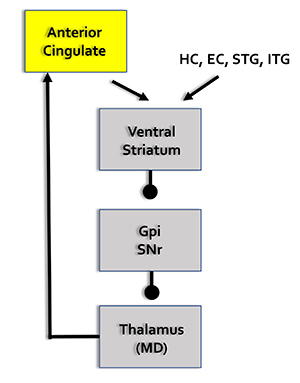
HC = hippocampal cortex,
EC = entorhinal cortex,
STG = superior temporal gyrus,
ITG = inferior temporal gyrus, posterior parietal cortex,
GPi = globus pallidus internal segment,
SNr = substantia nigra, pars reticulata,
MD = medial dorsal nucleus of the thalamus.
Motor Network
The
supplementary motor area (SMA), in concert with the premotor cortex, primary motor cortex, sensorimotor cortex, and cerebellum, plans, initiates, and inhibits voluntary movements and muscle contractions (Breedlove & Watson, 2020; Thompson & Thompson, 2016).
 SMA
SMA = supplementary motor area,
APA = arcuate premotor area,
PMC = primary motor cortex,
PSC = primary somatosensory cortex,
GPi = globus pallidus internal segment,
SNr = substantia nigra, pars reticulata,
VL = ventral lateral nucleus of the thalamus.
Oculomotor Network
The
frontal eye field (FEF), in concert with the dorsolateral prefrontal cortex, posterior parietal cortex, basal ganglia, and thalamus, programs and initiates voluntary eye movements, inhibits eye movements toward distracting stimuli, and allows us to return our focus to locations we've experienced in the past (Thompson & Thompson, 2016).
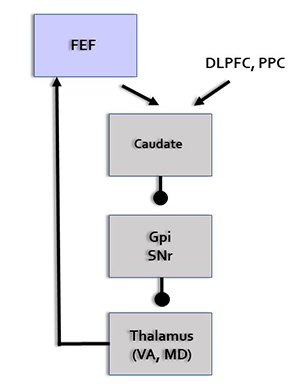 FEF
FEF = frontal eye field,
DLPFC = dorsolateral prefrontal cortex,
PPC = posterior parietal cortex,
GPi = globus pallidus internal segment,
SNr = substantia nigra, pars reticulata,
VA = ventral anterior nucleus of the thalamus,
MD = medial dorsal nucleus of the thalamus.
Social Network
The
orbitofrontal cortex (OFC), along with the basal ganglia and thalamus, orchestrates the highest level of emotional processing in the nervous system. The social network is responsible for socially responsible behavior, empathy, behavioral inhibition, emotional regulation, and sound judgment (Thompson & Thompson, 2016).
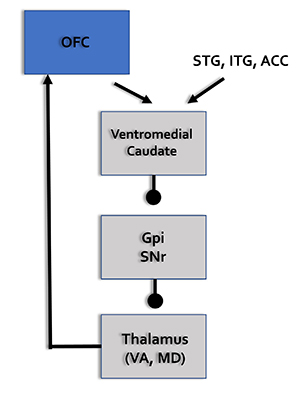 OFC
OFC = orbitofrontal cortex,
STG = superior temporal gyrus,
ITG = inferior temporal gyrus,
ACC = anterior cingulate cortex,
GPi = globus pallidus internal segment,
SNr = substantia nigra, pars reticulata,
VA = ventral anterior nucleus of the thalamus,
MD = medial dorsal nucleus of the thalamus.
Attentional Processes
Attention is the selection of sensory information or cognition for enhanced processing. We can overtly or covertly attend to stimuli. In
overt attention, our attentional focus and sensory orientation coincide. For example, you parse this sentence as you focus your gaze on it. In
covert attention, we shift our attentional focus from our sensory orientation. For example, you attend to a reminder on the corner of your screen while you gaze at this sentence. While the midbrain
superior colliculus is mainly implicated in overt attention, it may also regulate covert attention (Breedlove & Watson, 2023).
Attention is more selective than arousal, which is our overall level of alertness (Breedlove & Watson, 2023).
Research using divided attention tasks, where subjects simultaneously process multiple stimuli, shows that attentional resources are finite. The challenge of attending to more than one target at a time increases when they occupy different spatial locations. When we attend to a stimulus, we shift our attentional spotlight (focus) to select a stimulus for enhanced analysis (Bee & Micheyl, 2008).
Perceptual load (stimulus processing demands) determines the level at which an attentional bottleneck (stimulus selection) occurs. Complex stimuli, which involve a high perceptual load and monopolize processing resources, result in early selection where we filter out lower priority competing stimuli before preliminary perceptual and semantic analysis. Conversely, simple stimuli, which involve a low perceptual load and leave free processing resources, result in late selection where we filter out competing stimuli after performing extensive analysis (Lavie et al., 2004).
The Pulvinar Mediates Attentional Shifts
The
pulvinar nucleus, which comprises the posterior quarter of the human thalamus, processes visual information and directs attention. The pulvinar plays a pivotal role in processing visual information and shares widespread connections with the cingulate, parietal cortex, and superior colliculus. The pulvinar is crucial for orienting, shifting attention, and filtering out irrelevant stimuli. Tasks that present subjects with more distracting stimuli increase pulvinar activation, as shown by functional MRI (fMRI) (Buchsbaum et al., 2006). Graphic © Songkram Chotik-anuchit/Shutterstock.com.
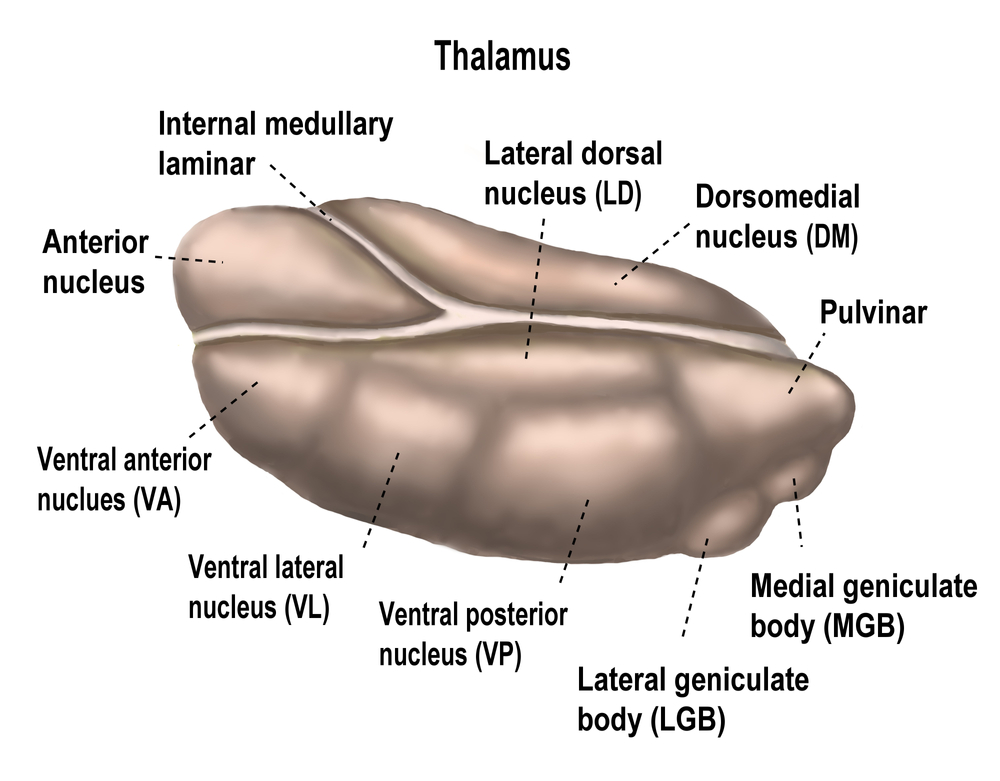
Overall, the pulvinar guides the processing of relevant information in wide-ranging cortical networks based on dynamically changing attentional priorities (Breedlove & Watson, 2023; Saalmann et al., 2012).
Cortical Regions That Guide Attention
The
dorsal frontoparietal system, which is comprised of the intraparietal sulcus and frontal eye field, is responsible for top-down direction of attention (Breedlove & Watson, 2023). The
intraparietal sulcus (IPS), located in the parietal lobe, provides voluntary top-down steering of attention (Corbetta & Shulman, 1998).
The
frontal eye field (FEF), found in the premotor region of the frontal lobes, directs gaze towards targets selected by the IPS (Paus et al., 1991). Target selection is guided by cognitive goals (top-down processing) rather than stimulus characteristics (bottom-up processing). The dorsal frontoparietal system was created by Simone Vossel, Joy J. Geng, Gereon R. Fink, CC BY 3.0.
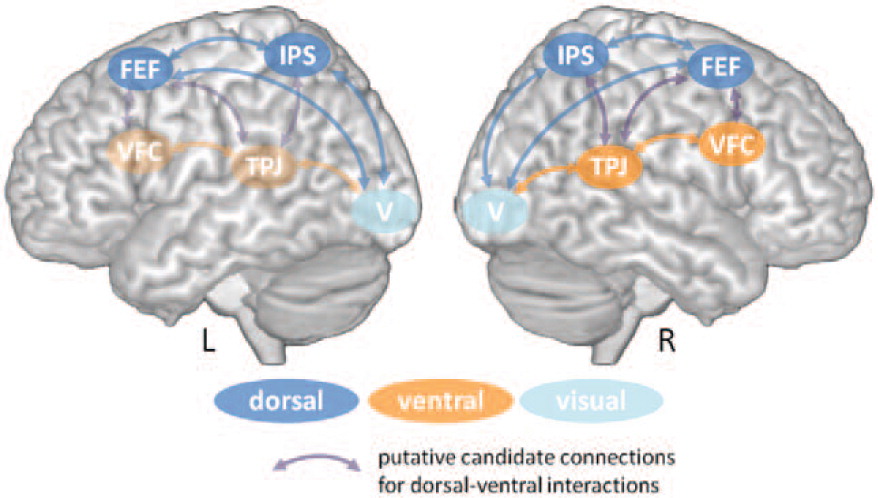
In contrast, the
temporoparietal junction (TPJ), where the superior temporal gyrus and inferior parietal lobe intersect, mediates bottom-up shifts in attention
in response to stimulus attributes (Corbetta & Shulman, 2002). The TPJ functions like a circuit breaker by overruling immediate attentional priorities and reallocating attentional resources to a new target (Breedlove & Watson, 2023).
Two Cortical Networks Regulate Attention
Two
cortical networks cooperatively regulate subcortical and cortical systems to produce a coherent perceptual experience (Breedlove & Watson, 2023). A
dorsal frontoparietal system provides top-down control of
endogenous attention (voluntary attention), directing the attentional spotlight to support cognitive system priorities. A
right temporoparietal system provides bottom-up control of
exogenous attention (involuntary reflexive attention), which redirects attention based on the novelty or importance of incoming stimuli.
Extensive interconnections between the two networks allow us to fluidly redirect attention from stimuli that are forebrain priorities (IPS) to those that are unexpected.
Salience Network
The
salience network comprises structures that seek to monitor our external and internal environments to determine which of these inputs are essential and require further processing and attention. The insula, primarily the anterior insula, is a crucial component of this network because it facilitates bottom-up access to the brain’s attentional and working memory resources (Menon & Uddin, 2010). The cingulate gyrus, particularly the right dorsal anterior cingulate cortex, is another crucial component (Thompson & Thompson, 2016). Graphic shared by Nekovarova, Fajnerova, Horacek, and Spaniel under the Creative Commons Attribution 3.0.
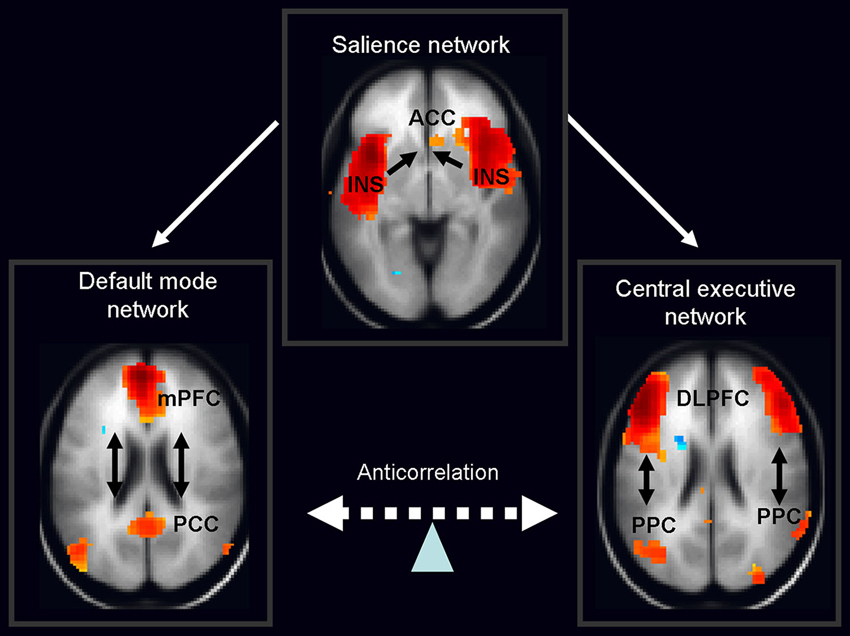
The
insula, which is a cortical region located within the lateral sulcus, functions as an integrative and organization hub for the salience network. The insula integrates interoceptive awareness, emotional experience, and external perception to facilitate an individual's global perception of the world and its relationship. The insula directs specific networks in processing salient stimuli and the generation of appropriate responses to stimuli (Wiebking & Northoff, 2014).
The insula graphic provided by
Fathy, Y.Y., Hoogers, S.E., Berendse, H.W. et al. Brain Imaging and Behavior (2019).
https://doi.org/10.1007/s11682-019-00099-3.
This file is licensed under the
Creative Commons Attribution 4.0 International license.
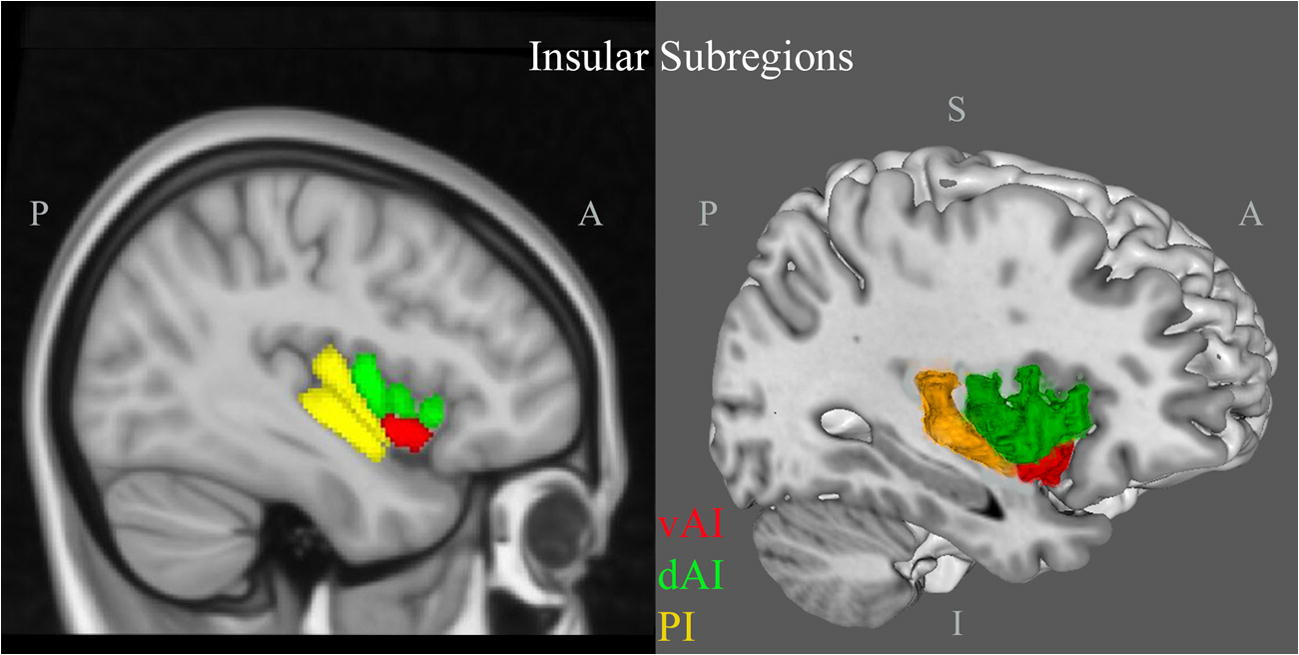
The insula appears to provide an interface between the human brain's cognitive, homeostatic, and affective systems. It, therefore, provides a link between the areas of the brain involved in monitoring internal signals and those engaged in watching incoming external sensory streams. The insula detects salient events via afferent pathways and switches between other large-scale networks when these events are recognized to guide attention and working memory.
The anterior and posterior insula interact to regulate
autonomic responses to salient stimuli. Interactive communication between the insula and anterior cingulate cortex facilitates access to the motor system (Menon & Uddin, 2010).
This network appears to help us switch between task-oriented (executive) and default mode (attention) networks (Seeley et al., 2007; Shirer et al., 2012).
Default Mode Network (DMN)
Brain regions are selectively active when we are conscious (Breedlove & Watson, 2020). The
default mode network (DMN) consists of frontal, temporal, and parietal lobe circuits active during spontaneous cognition like introspection, daydreaming, and streams of consciousness. The DMN appears to contribute flexible memory retrieval and idea generation, which are critical elements of creativity. The DMN is relatively inactive when pursuing external goals (Andrews-Hanna et al., 2010).
The DMN may contribute to
creative fluency, generating innovative ideas like alternative uses for everyday objects. A study of neurosurgical patients showed that left DMN stimulation reduced the number of uses but not their originality (Shofty et al., 2022).
The DMN graphic
shows default mode and task-related maps for healthy subjects. On a green background, the default mode network is highlighted in warm colors (red and yellow) and the task-related network is highlighted in cold colors (blue and light blue) depending on the
p-value of one sample
t-test. Authors are Shim, G., Oh, J. S., Jung, W. H., et al., CC BY 3.0.
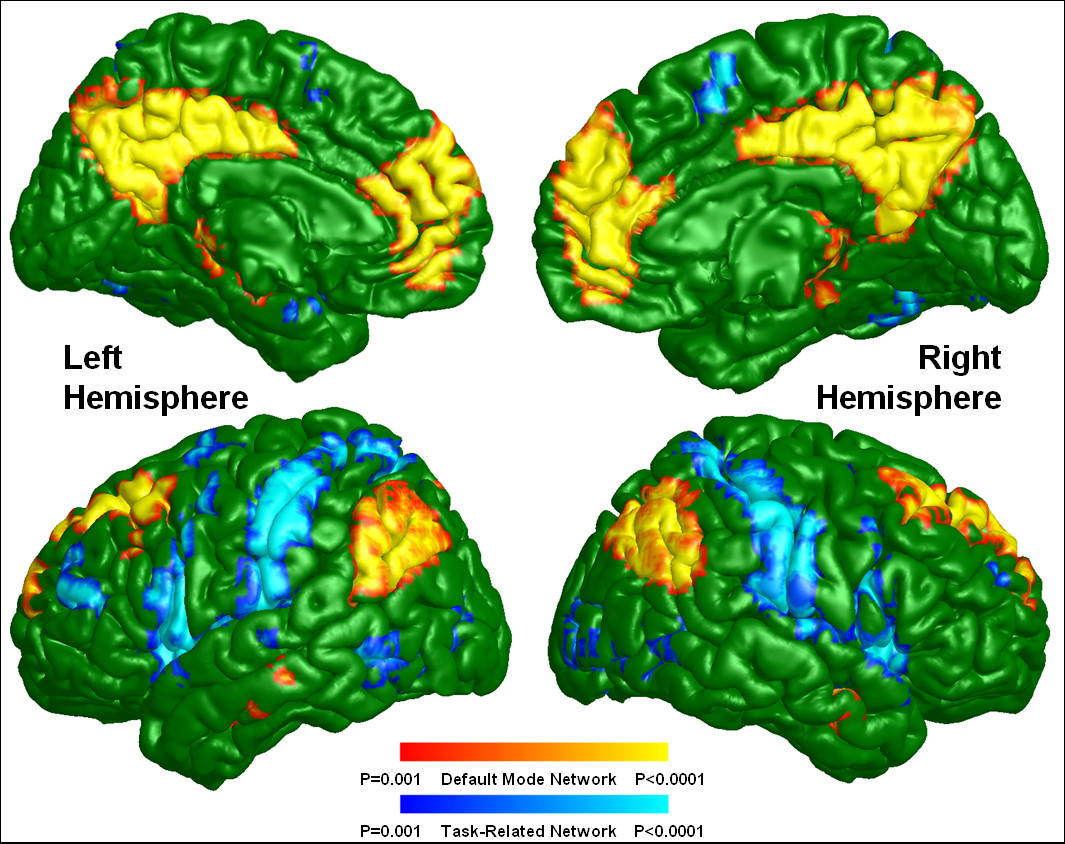
Understanding Ourselves
The
posterior cingulate cortex (PCC) and precuneus combine bottom-up attention with information from memory and perception. The ventral (lower) part of the PCC activates in all tasks which involve the DMN, including those related to the self or others, remembering the past, thinking about the future, processing concepts, and spatial navigation. The dorsal (upper) part of PCC mediates involuntary awareness and arousal. The precuneus is concerned with visual, sensorimotor, and attentional information.
The
medial prefrontal cortex (mPFC) participates in decisions about the self, such as personal information, autobiographical memories, future goals and events, and decision-making regarding those close to us like family members. The ventral (lower) part is involved in positive emotional information and reward.
The
angular gyrus connects perception, attention, spatial cognition, and action and helps us recall episodic memories.
Understanding Others
The major functional hubs include the PCC, mPFC, and angular gyrus. The
dorsal medial prefrontal cortex (dmPFC) analyzes others' objectives. The
temporoparietal junction (TPJ) constructs
theories of mind, which are models of others' cognitive processes, emotions, knowledge, and motivation. The
lateral temporal cortex is concerned with short-term verbal memory, naming, and reading.
Finally, the
anterior temporal pole is part of a bilateral semantic system representing object concepts and a left hemisphere-dominant network concerned with naming and understanding object names.
Autobiography and Future Simulations
The major functional hubs include the PCC, mPFC, and angular gyrus. The
hippocampus forms new declarative memories. The
parahippocampal cortex (PHC) mediates spatial memory, navigation, and high-level visual processing like facial recognition. The
retrosplenial cortex (RSC) is involved in episodic memory, navigation, predicting future events, and analyzing visual scenes. Finally, the
posterior inferior parietal lobe (pIPL) integrates sensory information and participates in top-down attentional orienting.
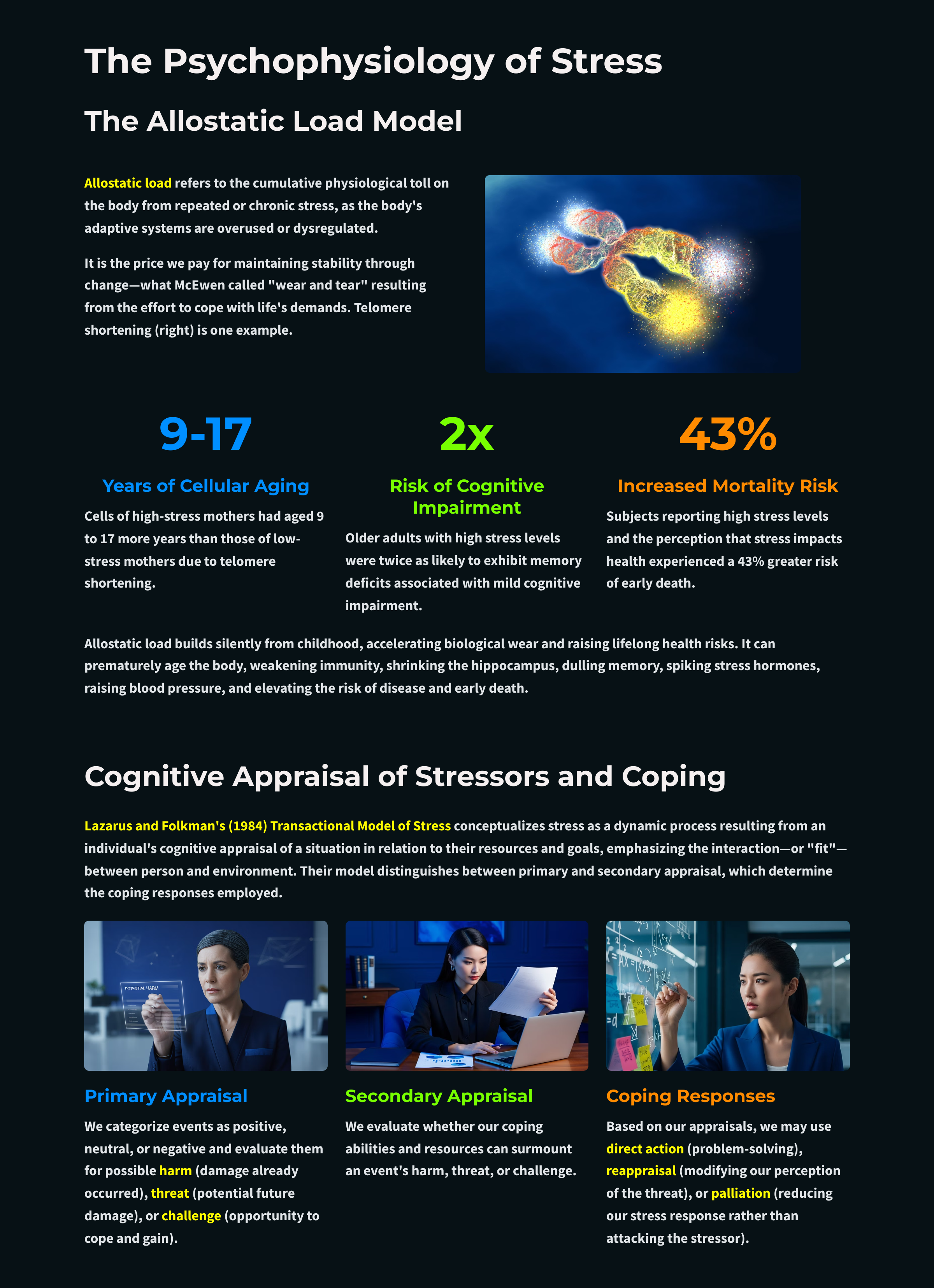
Glossary
acute stress response: autonomic changes that occur at the end of Selye’s
alarm stage, for example, increased heart rate.
adaptation energy: in Selye’s General Adaptation Syndrome, the capacity
of local organs to respond to the demands created by stressors. Depletion of adaptation energy theoretically
results in local adaptation syndromes like muscle fatigue and tissue inflammation.
adrenal cortex: the outer region of the adrenal gland that produces the hormone
cortisol.
adrenal medulla: the inner region of the adrenal gland that produces the hormones
epinephrine and norepinephrine.
affective intensity: in Barrett and Russell’s structural model, a
dimension that ranges from activated to deactivated states.
affective network: a network that is triggered when we make mistakes and that monitors cognitive activity to predict when errors are likely, and greater executive control may be needed. The affective network includes the anterior cingulate cortex, hippocampal cortex, entorhinal cortex, superior temporal gyrus, inferior temporal gyrus, posterior parietal cortex, globus pallidus internal segment, substantia nigra, pars reticulata, and medial dorsal nucleus of the thalamus.
affective valence: in Barrett and Russell’s structural model, a
dimension that ranges from unpleasant to pleasant affective states.
alarm: the first stage of Selye’s General Adaptation Syndrome that consists
of shock and countershock phases.
allostasis: the maintenance of stability through change by mechanisms that
anticipate challenge and adapt through behavior and physiological change.
allostatic load model: McEwen and Seeman’s hypothesis that when
stressors are acute or repeatedly occur, biological responses to stress can harm the body.
amygdala: limbic system structure that participates in evaluating whether
stimuli are threatening, establishing unconscious emotional memories, learning conditioned emotional responses,
and producing anxiety and fear responses.
arousal: overall level of alertness.
attention: the selection of sensory information or cognition for enhanced processing.
attentional bottleneck: a filter that limits enhanced processing to only the highest priority stimuli.
attentional spotlight: a shift of selective attention to
choose stimuli for enhanced processing.
biofeedback: (1) learning process that teaches an individual to control her
physiological activity, (2) biofeedback training aims to improve health and performance, (3)
instruments rapidly monitor an individual's performance and display it back to her, (4) the individual uses this
feedback to produce physiological changes, (5) changes in thinking, emotions, and behavior often accompany and
reinforce physiological changes, and (6) these changes become independent of external feedback from instruments.
Information about psychophysiological performance is obtained by noninvasive monitoring and used to help
individuals achieve self-regulation through a learning
process that resembles motor skill learning.
biopsychosocial model: Engel’s perspective that the complex interplay of
psychological, biological, and sociological factors results in health or illness.
catecholamines: chemical compounds containing catechol and amine groups, like
dopamine, epinephrine, and norepinephrine, derived from the amino acid tyrosine.
central executive network: structures including the dorsolateral prefrontal cortex, anterior cingulate cortex, and orbitofrontal cortex responsible for cognitive regulation of behavior.
central nucleus of the amygdala: the region of the amygdala that orchestrates the
amygdala’s response to stressors. For example, it activates the paraventricular nucleus (PVN) of the
hypothalamus, resulting in increased CRH release to the pituitary gland.
challenge: in Lazarus and Folkman’s Transactional Model of stress, an
individual’s assessment during primary appraisal of her potential to cope with an event and gain from this
opportunity.
cingulate cortex: cortex which lies above the corpus callosum that is responsible for the motivation dimension of attention, like pain due to physical injury and social rejection.
conditioned response (CR): in classical conditioning, a response (blood
pressure rise) elicited by a conditioned stimulus (criticism).
conditioned stimulus: in classical conditioning, a stimulus (dentist's
office), that in association with an unconditioned stimulus (pain), elicits an unconditioned response (anxiety)
like the original unconditioned response.
corticotropin (ACTH): the hormone released by the pituitary gland following CRH
binding that triggers cortisol release by the adrenal cortex.
corticotropin releasing hormone (CRH): the hormone released by the hypothalamus
that triggers ACTH release by the pituitary gland.
cortisol: a glucocorticoid produced by the adrenal cortex that helps convert fat
and protein to glucose and reduces inflammation.
countershock phase: the last part of Selye’s alarm stage of the General
Adaptation Syndrome during which resistance increases due to increased activity by local defenses.
covert attention: an attentional focus independent of sensory orientation.
creative fluency: generating creative ideas like alternative uses for everyday objects.
default mode network: frontal, temporal, and parietal lobe circuits that are active during introspection and daydreaming and relatively inactive when we pursue external goals.
diathesis: inherited or acquired biological vulnerability. For example,
obesity is a diathesis for diabetes.
diseases of adaptation: in Selye’s General Adaptation Syndrome,
depletion of adaptation energy theoretically results in adaptation syndromes like atrial tachycardia.
distress: Selye’s term for stress due to negative stimuli.
divided attention tasks: situations where subjects must simultaneously process two or more stimuli.
dorsal frontoparietal system: the network comprised of the intraparietal sulcus and frontal eye field responsible for the top-down direction of attention.
dorsolateral prefrontal cortex: the left dorsolateral prefrontal cortex is concerned with approach behavior and positive affect. It helps us select positive goals and organizes and implements behavior to achieve these goals. The right dorsolateral prefrontal cortex organizes withdrawal-related behavior and negative affect and mediates threat-related vigilance. It plays a role in working memory for object location.
dove strategy: passive, reactive, nonaggressive, and cautious response to
stressors.
early selection: filtering out lower-priority competing stimuli before preliminary perceptual and semantic analysis.
endogenous attention: voluntary attention that directs the attentional spotlight
to support cognitive system priorities.
epinephrine: adrenal medulla hormone that increases muscle blood flow, converts stored nutrients into glucose for use by skeletal muscles, and initiates cardiac muscle contraction when it binds to β1 receptors.
eustress: Selye’s term for stress due to positive stimuli.
executive network: a network responsible for allocating attention, cognitive inhibition, behavioral inhibition, working memory, and cognitive flexibility. The executive network includes the dorsolateral prefrontal cortex, posterior parietal cortex, arcuate premotor area, globus pallidus internal segment, substantia nigra, pars reticulata, ventral anterior nucleus of the thalamus, and medial dorsal nucleus of the thalamus.
exhaustion: the third stage of Selye’s General Adaptation Syndrome during
which increased endocrine activity depletes body resources and raises cortisol levels resulting in suppressed
immunity, stress syndrome symptoms, and possible hospitalization and death.
exogenous attention:
involuntary reflexive attention that redirects attention based on the novelty or importance of incoming stimuli.
fight-or-flight response: Cannon’s response of confronting or fleeing a
threat that occurs at the end of Selye’s alarm stage.
frontal eye field (FEF): region of the premotor cortex that
directs gaze towards targets selected by the IPS.
General Adaptation Syndrome (GAS): Selye proposed that diverse stressors
produce a three-stage (alarm, resistance, and exhaustion) autonomic and endocrine response in all subjects.
harm: in Lazarus and Folkman's Transactional Model of Stress, damage that has
already occurred. For example, a heart attack survivor may perceive harm as damage to the heart muscle.
hassle: minor stressful event, for example, waiting in a checkout line.
Hassles and Uplifts Scale: DeLongis, Folkman, and Lazarus’s revised
53-item scale measured hassle frequency and intensity. This scale better predicted headache frequency and
intensity and inflammatory bowel disease frequency than the Social Readjustment Rating Scale (SRRS).
Hassles Scale: Kanner and colleagues’ 117-item scale that measures
negative daily experiences.
hawk strategy: a proactive and bold response to stressors.
heart rate variability (HRV): beat-to-beat changes in heart rate, including changes in the RR intervals between consecutive heartbeats.
hippocampal formation: the limbic structure involved in controlling the endocrine
system’s response to stressors, formation of explicit memories, and navigation. Cortisol binding to this
structure disrupts these functions, interferes with creating new neurons, and harms and kills hippocampal
neurons.
hypothalamic-pituitary-adrenal (HPA) axis: the hormonal cascade that starts with
signals from the amygdala to the hypothalamus and ultimately targets the adrenal glands, releasing the hormones
CRH, ACTH (corticotropin), and cortisol.
hypothalamus: a forebrain structure located below the thalamus that dynamically
maintains homeostasis by controlling the autonomic nervous system, endocrine system, survival behaviors,
and interconnections with the immune system.
insula: the cortical region located within the lateral sulcus of the frontal, parietal, and temporal lobes that functions as an integrative and organization hub for the salience network.
intraparietal sulcus (IPS): the region of the parietal lobe that provides voluntary top-down steering of attention.
late selection:
filtering out competing stimuli after performing extensive analysis.
locus of control: Rotter’s concept of a continuum of control of outcomes
where
internals attribute outcomes to their efforts and
externals attribute them to external
events. This concept overlaps with the concepts of mastery, perceived control, and self-efficacy.
mastery: the relatively stable expectancy that we can control our personal
outcomes. This concept overlaps with the concepts of locus of control, perceived control, and self-efficacy.
microbiome: the collection of the microorganisms that reside in the human body.
motor network: the network that plans, initiates and inhibits voluntary movements and muscle contractions. The motor network includes the supplementary motor area, premotor cortex, primary motor cortex, primary somatosensory cortex, cerebellum, arcuate premotor area, globus pallidus internal segment, substantia nigra, pars reticulata, and ventral lateral nucleus of the thalamus.
myelinated vagus: in Porges' polyvagal theory, the phylogenetically newer ventral vagal complex that rapidly adjusts cardiac output and promotes social engagement.
negative affective states: in Barrett and Russell’s structural model,
unpleasant states like sadness are located in the left hemisphere.
negative affectivity: a predisposition toward distress and dissatisfaction. Individuals who are rated
high on this trait negatively perceive themselves, others, and the environment and have a pessimistic
perspective.
neurofeedback: information about EEG activity obtained by
noninvasive monitoring and used to help individuals achieve self-regulation through a learning process that
resembles motor skill learning.
neuroplasticity: the ability of neurons and their networks to remodel themselves in response to experience.
norepinephrine: an adrenal medullary hormone that increases muscle blood flow and
converts stored nutrients into glucose for skeletal muscles.
nucleus (PVN) of the hypothalamus: when activated by the central nucleus of
the amygdala, this nucleus releases CRH to the pituitary gland.
oculomotor network: a network that programs and initiates voluntary eye movements, inhibits eye movements toward distracting stimuli, and allows us to return our focus to locations we've experienced in the past. The oculomotor network includes the frontal eye field, dorsolateral prefrontal cortex, posterior parietal cortex, caudate, globus pallidus internal segment, substantia nigra, pars reticulata, ventral anterior nucleus of the thalamus, and medial dorsal nucleus of the thalamus.
overt attention:
the agreement between attentional focus and sensory orientation.
oxytocin: a hormone and neurotransmitter that may contribute to social bonding, anxiety following exposure to stressors, and the milk letdown reflex.
palliation: in Lazarus and Folkman’s Transactional Model of Stress,
secondary appraisal can lead to efforts to reduce our stress response rather than attack the stressor.
parasympathetic responder: a response stereotypy in which an individual may
increase digestive activity, constrict the lungs' alveoli, and faint from low blood pressure when challenged
by stressors.
perceived control: an individual’s expectancy that she can influence her
outcomes. This concept overlaps with the concepts of locus of control, mastery, and self-efficacy.
Perceived Stress Scale (PSS): Cohen and colleagues’ scale that measures
perceived hassles, major life changes, and shifts in coping resources during the previous month using a 14-item
scale. PSS items assess the degree to which respondents rate their lives as unpredictable, uncontrollable, and
overloaded.
perceptual load:
stimulus processing demands.
pituitary gland: the endocrine gland found at the base of the skull that is
divided into the
anterior pituitary, which secretes the tropic hormones adrenocorticotropic hormone
(ACTH), thyroid-stimulating hormone (TSH), follicle-stimulating hormone (FSH), luteinizing hormone (LH),
prolactin, and growth hormone (GH), and the
posterior pituitary that releases oxytocin or vasopressin
produced by the hypothalamus.
polyvagal theory: Porges' theory that the unmyelinated vagus (dorsal vagus complex) and newer myelinated vagus (ventral vagal complex) mediate competing adaptive responses.
positive states: in Barrett and Russell’s structural model, pleasant
states like contentment are located in the right hemisphere.
posttraumatic stress disorder (PTSD): severe and long-lasting trauma and stressor-related disorder
that often develops within three months of a traumatic event and may include re-experiencing a traumatic event,
avoidance of stimuli associated with the trauma, numbing of responsiveness, and hyperarousal.
prefrontal cortex: the most anterior region of the frontal lobes divided
into orbitofrontal and ventromedial, dorsolateral prefrontal cortex, and anterior and ventral cingulate cortex
subdivisions, and is responsible for the brain’s executive functions.
primary appraisal: in Lazarus and Folkman’s Transactional Model of Stress,
the first stage of our response to an event during which we categorize the consequences of events as positive,
neutral, or negative and determine whether an event is relevant and negative, or potentially harmful. We evaluate
these events for their possible harm, threat, or challenge.
psychoneuroimmunology: Solomon and Moos’ term for a multidisciplinary
field that studies the interactions between behavior and the nervous system, endocrine system, and immune
system.
pulvinar nucleus: the posterior region of the thalamus that processes visual information and directs attention.
raphe system: a network of serotonergic neurons located in the brainstem that
includes anxiety-producing and anxiety-reducing pathways that terminate on the hippocampus.
reappraisal: in Lazarus and Folkman’s Transactional Model of Stress,
secondary appraisal can modify our perception of a threat when direct action is impractical or
unsuccessful.
resistance: the second stage of Selye’s General Adaptation Syndrome where
local defenses have made the generalized stress response unnecessary. Both cortisol output and stress symptoms,
like adrenal gland enlargement, decline.
response stereotypy: a person’s unique response pattern to stressors of
identical intensity.
salience network: structures including the insula and anterior cingulate cortex that seek to monitor our external and internal environments to determine which of these inputs are
salient and require further processing and attention.
secondary appraisal: in Lazarus and Folkman’s Transaction Model of
Stress, the second stage of our response to an event during which we evaluate whether our coping abilities and
resources can surmount an event's harm, threat, or challenge.
self-efficacy: an individual’s expectancy that they can influence her
outcomes. This concept overlaps with the concepts of locus of control, mastery, and perceived control.
shock phase: the first part of Selye’s alarm stage of the General Adaptation
Syndrome that includes the reduced body stress resistance and increased autonomic arousal and hormone release
(ACTH, cortisol, epinephrine, and norepinephrine) that comprise the “fight-or-flight” response.
social network: the network that mediates socially responsible behavior, empathy, behavioral inhibition, emotional regulation, and sound judgment. The social network includes the orbitofrontal cortex, superior temporal gyrus, inferior temporal gyrus, anterior cingulate cortex, caudate, globus pallidus internal segment, substantia nigra, pars reticulata, ventral anterior nucleus of the thalamus, and medial dorsal nucleus of the thalamus.
Social Readjustment Rating Scale (SRRS): Holmes and Rahe measured major
positive and negative life changes using their Social Readjustment Rating Scale (SRRS), which lists 43 events, each
assigned a different Life Change Unit (LCU) value.
stress: Selye’s term for a nonspecific response to stimuli called
stressors.
stress-diathesis model: the view that stressors interact with our inherited or
acquired biological vulnerabilities, diatheses, to produce medical and psychological symptoms.
stressors: Selye’s term for stimuli that elicit the stress response.
structural model: Barrett and Russell's representation of affective states
within a circumplex (circular structure) based on its degrees of affective valence (unpleasant to pleasant) and
affective intensity (activation to deactivation).
superior colliculus: the dorsal midbrain structure composed of gray matter that processes visual information, directs visual gaze and visual attention to selected stimuli, and participates in overt and covert attention.
sympathetic nervous system (SNS): autonomic nervous system branch that
regulates activities that expend stored energy, such as when we are excited.
sympathetic responder: a response stereotypy in which an individual may
increase blood pressure, heart rate, and sweat gland activity and decrease heart rate variability and peripheral
blood flow pressure when challenged by stressors.
sympathetic-adrenomedullary path (SAM) pathway: during an acute stress
response, the sympathetic nervous system directs the release of the hormones epinephrine and norepinephrine by the
adrenal medulla.
telomerase: an enzyme that adds DNA to telomeres. Telomerase levels decline with
chronic stress and cellular aging.
telomere: DNA and protein that cover the ends of chromosomes. Telomeres
shorten with chronic stress and cellular aging.
temporoparietal junction (TPJ): the intersection of the
superior temporal gyrus and inferior parietal lobe that mediates bottom-up shifts in attention
in response to stimulus attributes.
tend-and-befriend response: Taylor and colleagues’ proposition that
women may
tend (nurture others) and
befriend (seek and provide social support) in response to
stressors.
threat: in Lazarus and Folkman’s Transactional Model of Stress, we evaluate events for the damage they could inflict in the future during primary appraisal.
Transactional Model of Stress: Lazarus and Folkman’s cognitive model proposed that stress is determined by our perception of the situation.
traumatic stress: stress produced by a highly intense stressor that
disrupts coping and endangers ourselves or others.
unmyelinated vagus:
in Porges' polyvagal theory, the phylogenetically older dorsal vagus complex that responds to threats through immobilization, feigning death, passive avoidance, and shutdown.
uplift: a minor positive event like receiving an unexpected call from a
friend.
vagal withdrawal: the inhibition of the myelinated vagus, often by daily stressors.
ventromedial prefrontal cortex: region of the prefrontal cortex may play a
role in calculating risk and the emotional responses of anxiety and fear. Cortisol binding to this
structure increases anxiety and fear and disrupts and kills neurons.
Yerkes-Dodson curve: an inverted U-curve that illustrates the relationship between pressure and performance.
TEST YOURSELF ON CLASSMARKER
Click on the ClassMarker logo below to take a 10-question exam over this entire unit.

REVIEW FLASHCARDS ON QUIZLET
Click on the Quizlet logo to review our chapter flashcards.

Visit the BioSource Software Website
BioSource Software offers
Physiological Psychology, which satisfies BCIA's Physiological Psychology requirement, and
Neurofeedback100, which provides extensive multiple-choice testing over the Biofeedback Blueprint.

Assignment
Now that you have completed this module, how has it changed your understanding of stress? Explain how the top-down and bottom-up attentional systems work together to direct our focus.
References
Alexander, G. E., DeLong, M. R., & Strick, P. L. (1986). Parallel organization of functionally segregated circuits linking basal ganglia and cortex.
Annual Review of Neuroscience, 9, 357-381. https://doi.org/10.1146/annurev.ne.09.030186.002041
American Psychiatric Association (APA). (2013).
Diagnostic and
statistical manual of mental disorders (5th ed.).
Author.
Andreassi, J. L. (2000).
Psychophysiology: Human behavior and
physiological response. Lawrence Erlbaum Associates,
Publishers.
Andrews-Hanna, J. R., Reidler, J. S., Huang, C., & Buckner, R. L. (2010).
Evidence for the default network's role in spontaneous cognition.
J Neurophysiol., 104, 1664-1671. https://doi.org/10.1152/jn.00830.2009
Asterita, M. F. (1985).
The physiology of stress. Human
Sciences Press, Inc.
Bangasser, D. A. (2013).
Sex differences in stress-related receptors: 'Micro' differences with 'macro' implications for mood and anxiety disorders.
Biology of Sex Differences, 4(1), 2. https://doi.org/10.1186/2042-6410-4-2
Bangasser, D. A., & Valentino, R. J. (2014).
Sex differences in stress-related psychiatric disorders: Neurobiological perspectives.
Frontiers in Neuroendocrinology, 35(3), 303-319. https://doi.org/10.1016/j.yfrne.2014.03.008
Barrett, L. F., & Russell, J. A. (1998).
Independence and bipolarity in the structure of current affect.
Journal of Personality and Social
Psychology, 74, 967-984. https://doi.org/10.1037/0022-3514.74.4.967
Bee, M. A., & Micheyl,
C. (2008).
The cocktail party problem: What is it? How can it be solved? And why should animal behaviorists study it?
Journal of Comparative Psychology, 122(3), 235-251. https://doi.org/10.1037/0735-7036.122.3.235
Brannon, L., Updegraff, J. A., & Feist, J. (2022).
Health psychology (10th ed.).
Wadsworth, Cengage Learning.
Breedlove, S., M., & Watson, N. V. (2023).
Behavioral neuroscience (10th ed.). Sinauer Associates, Inc.
Brett, J. F., Brief, A. P., Burke, M. J., George, J.
M., & Webster, J. (1990). Negative affectivity and the reporting of stressful life events. Health Psychology, 9, 57-68. https://doi.org/10.1037//0278-6133.9.1.57
Buchsbaum, M. S., Buchsbaum, B. R., Chokron, S., Tang, C., Wei, T. C., & Byne, W. (2006). Thalamocortical circuits: fMRI assessment of the pulvinar and medial dorsal nucleus in normal volunteers. Neuroscience Letters, 404(3), 282-287. https://doi.org/10.1016/j.neulet.2006.05.063
Cannon, W. (1932). The wisdom of the body. Norton.
Carney, R. M., Blumenthal, J. A., Freedland, K. E., Stein, P. K.,
Howells, W. B., Berkman, L. F., Watkins, L. L., Czajkowski, S. M., Hayano,
J., Domitrovich, P. P., & Jaffe, A. S. (2005). Low heart rate variability and the effect of depression on post-myocardial infarction mortality.
Archives of Internal Medicine, 165, 486-1491. https://doi.org/10.1001/archinte.165.13.1486
Carpenter, S. (2012). That gut feeling. Monitor on Psychology, 43(8), 50.
Cohen, S., Doyle, W. J., Skoner, D. P., Rabin, B. S., Gwaltney, J. M., &
Newson, J. T. (1995). State and trait negative affect as predictors of objective and subjective symptoms of respiratory viral infections. Current Directions in Psychological
Science, 5, 86-90. https://doi.org/10.1037//0022-3514.68.1.159
Corbetta, M., & Shulman, G. I. (1998). Human cortical mechanisms of visual attention during orienting and search. Philosophical Transactions of the Royal Society of London. Series B: Biological Sciences, 353(1373), 1353-1362. https://doi.org/10.1098/rstb.1998.0289
Corbetta, M., & Shulman, G. I. (2002). Control of goal-directed and stimulus-driven attention in the brain. Nature Reviews: Neuroscience, 3(3), 201-215. https://doi.org/10.1038/nrn755
Crandall, C. S., Preisler, J. J., & Aussprung, J. (1992). Measuring life event stress in the lives of college students: The Undergraduate Stress Questionnaire (USQ). Journal
of Behavioral Medicine, 15, 627-662. https://doi.org/10.1007/BF00844860
David, D. H., & Lyons-Ruth (2005). Differential attachment responses of male and female infants to frightening maternal behavior: Tend or brief versus fight or flight? Infant
Mental Health Journal, 26, 1-18. https://doi.org/10.1002/imhj.20033
DeLongis, A., Folkman, S., & Lazarus, R. S. (1988). The impact of daily stress on health and mood. Psychological and social resources as mediators. Journal of Personality and Social Psychology, 54,
486-495. https://doi.org/10.1037/0022-3514.54.3.486
Dohrenwend, B. S., & Dohrenwend, B. P. (1984). Life stress and illness:
Formulation of the issues. In B. S. Dohrenwend & B. P. Dohrenwend (Eds.).
Stressful life events and their contexts (pp. 1-27). Rutgers University Press.
Engel, G. L. (1971). Sudden and rapid death during psychological stress. Folklore or folk wisdom? Annals of Internal Medicine, 74, 771-782. https://doi.org/10.7326/0003-4819-74-5-771
Engel, G. L. (1977). The need for a new medical model: A challenge for biomedicine. Science, 196, 129-136. https://doi.org/10.1126/science.847460
Engel, G. L. (1980). The clinical application of the biopsychosocial model. American Journal of Psychiatry, 137, 535-544. PMID: 7369396
Ferguson, E., Williams, L., O'Connor, R. C., Howard, S., Hughes, B. M., Johnston, D. W., Allan, J. L., O'Connor, D. B., Lewis, C. A., Grealy, M. A., & O'Carroll, R. E.
(2009).
A taxometric analysis of Type-D personality.
Psychosomatic Medicine, 71(9), 981-986. https://doi.org/10.1097/PSY.0b013e3181bd888b
Fox, I., & Rompolski, K. (2022).
Human physiology (16th ed.). McGraw Hill.
Frasure-Smith, N., Lesperance, F., & Talajic, M. (1995).
Depression and 18-month prognosis after myocardial infarction.
Circulation,
91(4), 999-1005. https://doi.org/10.1161/01.cir.91.4.999
Gaidos, S. (2016). He stress, she stress: Scientists puzzle over why men and women react differently to pressure.
Science News,
189(2), 18-21.
Gunthert, K. C., Cohen, L. H., & Armeli, S. (1999).
The role of neuroticism in daily stress and coping.
Journal of Personality and
Social Psychology, 77, 1087-1100. https://doi.org/10.1037//0022-3514.77.5.1087
Harrell, E. H., Kelly, K., & Stutts, W. A. (1996). Situational
determinants of correlations between serum cortisol and self-reported
stress measures.
Psychology: A Journal of Human Behavior, 33,
22-25.
Holmes, T. H., & Rahe, R. H. (1967).
The Social Readjustment Rating Scale.
Journal of Psychosomatic Research, 11, 213-218. https://doi.org/10.1016/0022-3999(67)90010-4
Johnson, J. H. (1986).
Life events as stressors in childhood and
adolescence. Sage.
Johnston-Brooks, C. H., Lewis, M. A., Evans, G. W., Whalen, C. K. (1998).
Chronic stress and illness in children: The role allostatic load.
Psychosomatic Medicine, 60,
597-603. https://doi.org/10.1097/00006842-199809000-0001
Kanner, A. D., Coyne, J. C., Schaefer, C., & Lazarus, R. S. (1981).
Comparison of two modes of stress measurement: Daily hassles and uplifts versus major life events.
Journal of Behavioral Medicine, 4, 1-39. https://doi.org/10.1007/bf00844845
Karlamangla, A. S., Singer, B. H., & Seeman, T. E. (2006).
Reduction in allostatic load in older adults is associated with lower all-cause mortality risk: MacArthur studies of successful aging.
Psychosomatic Medicine,
68, 500-507. https://doi.org/10.1097/01.psy.0000221270.93985.82
Katz, M. J., Derby, C. A., Wang, C., Sliwinski, M. J., Martin, J., Ezzati, A., . . . Lipton, R. B. (in press).
Influence of perceived stress on incident amnestic mild cognitive impairment: Results from the Einstein Aging Study. Alzheimer Disease & Associated Disorders.
https://doi.org/10.1097/WAD.0000000000000125
Kawamura, N., Kim, Y., & Asukai, N. (2001).
Suppression of cellular immunity in men with a past history of posttraumatic stress disorder.
American Journal of Psychiatry, 158, 484-486. https://doi.org/10.1176/appi.ajp.158.3.484
Keller, A., Litzelman, K., Wisk, L. E., Maddox, T., Cheng, E. R., Creswell, P. D., & Witt, W. P. (2012).
Does the perception that stress affects health matter? The association with health and mortality.
Healthy Psychology, 31(5), 677-684. https://doi.org/10.1037/a0026743.
Kemeny, M. E. (2003).
The psychobiology of stress.
Current Directions in Psychological Science, 12,
124-129. https://doi.org/10.1111/1467-8721.01246
Kessler, R. C., Berglund, P., Delmer, O., Jin, R., Merikangas, K. R., & Walters, E .E. (2005).
Lifetime prevalence and age-of-onset distributions of DSM-IV disorders in the National Comorbidity Survey Replication.
Archives of General Psychiatry, 62(6), 593-602. https://doi.org/10.1001/archpsyc.62.6.593
Khazan, I. (2013).
The clinical handbook of biofeedback: A step-by-step guide for training and practice with mindfulness. John Wiley & Sons, Ltd.
Kivlinghan, K. T., Granger, D. A., & Booth, A. (2005).
Gender differences in testosterone and cortisol response to competition.
Psychoneuroendocrinology, 30, 58-71. https://doi.org/10.1016/j.psyneuen.2004.05.009
Kroptov, J. D. (2009).
Quantitative EEG, event-related potentials and neurotherapy. Academic Press, Elsevier.
Lacey, K., Zaharia, M. D., Griffiths, J., Ravindran, A. V., Merali, Z., &
Anisman, H. (2000).
A prospective study of neuroendocrine and immune alterations associated with the stress of an oral academic examination among graduate students.
Psychoneuroendocrinology, 25, 339-356. https://doi.org10.1016/s0306-4530(99)00059-1
Lavie, N., Hirst, A., de Fockert, J. W., & Viding, E. (2004).
Load theory of selective attention and cognitive control.
Journal of Experimental Psychology: General, 133(3), 339-354. https://doi.org/10.1037/0096-3445.133.3.339
Lazarus, R. S. (1984).
Puzzles in the study of daily hassles.
Journal
of Behavioral Medicine, 7, 375-389. https://doi.org/10.1007/BF00845271
Lazarus, R. S., & Folkman, S. (1984).
Stress, appraisal, and coping.
Springer.
Mason, J. W. (1971).
A reevaluation of the concept of "nonspecificity" in stress theory.
Journal of Psychiatric Research, 8, 323-333.
McEwen, B. S. (2000).
Allostasis and allostatic load: Implications for neuropsychopharmacology.
Neuropsychopharmacology, 22,108-124.
McEwen, B. S. (2002).
The end of stress as we know it. Joseph Henry Press.
McEwen, B. S. & Seeman, T. (1999). Protective and damaging effects of
mediators of stress: Elaborating and testing the concepts of allostasis
and allostatic load. In Adler, N. E., Marmot, M., McEwen, B. S. & Stewart,
J. (Eds.).
Socioeconomic Status and Health in Industrial Nations:
Social, Psychological and Biological Pathways. Ann NY Acad Sci, 896.
McEwen, B. S. & Seeman, T. (2003). Stress and affect: Applicability of
the concepts of allostasis and allostatic load. In R. J. Davidson, K. R.
Scherer, & H. H. Goldsmith (Eds.)
Handbook of affective sciences.
Oxford University Press.
McEwen, B. S., & Stellar, E. (1993).
Stress and the individual: Mechanisms leading to disease.
Archives of Internal Medicine, 153,
2093-2101. PMID: 8379800
McGonagle, K. A., & Kessler, R. C. (1990).
Chronic stress, acute stress, and depressive symptoms.
American Journal of Community Psychology, 18,
681-706. https://doi.org/10.1007/BF00931237
Menon, V., & Uddin, L. Q. (2010).
Saliency, switching, attention and control: A network model of insula function.
Brain Struct Function, 214(5-6), 655-667. https://doi.org/10.1007/s00429-010-0262-0
Ng, D. M., & Jefferey, R. W. (2003).
Relationships between perceived stress and health behaviors in a sample of working adults.
Health Psychology, 22, 638-642. https://doi.org/10.1037/0278-6133.22.6.638
O'Dowd, T. C. (1987). To burn out or to rust out in general practice.
J R Coll Gen Pract, 37(300), 290-291. PMID: 3449629
Paus, T., Kalina, M., Patocková, L., Angerová, Y., Cerný, R., Mecir, P., Bauer, J., & Krabec, P. (1991).
Medial vs lateral frontal lobe lesions and differential impairment of central-gaze fixation maintenance in man.
Brain, 114, 2051-2067. https://doi.org/10.1093/brain/114.5.2051
Rahe, R. H., & Arthur, R. J. (1978).
Life change and illness studies: Past history and future directions.
Journal of Human Stress, 4,
3-15. https://doi.org/10.1080/0097840X.1978.9934972
Ray, C., Jefferies, S., & Weir, W. R. (1995).
Life-events and the course of chronic fatigue syndrome.
British Journal of Medical Psychology, 68,
323-331. https://doi.org/10.1080/0097840X.1978.9934972
Ross, C. E., & Mirowsky, J. (1979).
A comparison of life-event-weighting schemes: Change, undesirability, and effect-proportional indices.
Journal of Health and Social Behavior, 20, 166-177. PMID: 479528
Russell, J. A., & Barrett, L. F. (1999).
Core affect, prototypical emotional episodes, and other things called emotion: Dissecting the elephant.
Journal of Personality and Social Psychology, 76(5), 805-819. https://doi.org/10.1037//0022-3514.76.5.805
Saalmann, Y. B., Pinsk, M. A., Wang, L., Li, X., & Kastner, S. (2012).
The pulvinar regulates information transmission between cortical areas based on attention demands.
Science, 337(6095), 753-756. https://doi.org/10.1126/science.1223082
Saey, T. H. (2016).
Body's bacteria don't outnumber human cells so much after all: New calculations suggest roughly equal populations, not 10-to-1 ratio.
Science News. Retrieved from https://www.sciencenews.org
Schwartz, G. E. (1982).
Testing the biopsychosocial model: The ultimate challenge facing behavioral medicine? Journal of Consulting and
Clinical Psychology, 50, 1040-1053.
Seeley, W. W., Menon, V., Schatzberg, A. F., Keller, J., Glover, G. H., Kenna, H., . . .
Greicius, M. D. (2007).
Dissociable intrinsic connectivity networks for salience processing and executive control.
J Neurosci, 27(9), 2349-2356. doi:10.1523/JNEUROSCI.5587-06.2007
Seeman, T. E., Singer, B. H., Rowe, J. W., Horwitz, R. I., & McEwen, B.
S. (1997).
Price of adaptation—allostatic load and its health consequences.
Archives of Internal Medicine, 157, 2259-2268. PMID: 9343003
Selye, H. (1956).
The stress of life. McGraw-Hill.
Selye, H. (1974).
Stress without distress. Lippincott.
Selye, H. (1976).
Stress in health and disease. Butterworth.
Sender, R., Fuchs, S., & Milo, R. (2016),
Revised estimates for the number of human and bacteria cells in the body.
BioRxiv. Posted online January 6, 2016.
Serido, J., Almeida, D. M., & Wethington, E. (2004).
Chronic stress and daily hassles: Unique and interactive relationships with psychological distress.
Journal of Health and Social Behavior, 45, 17-33. https://doi.org/10.1177/002214650404500102
Shirer, W. R., Ryali, S., Rykhlevskaia, E., Menon, V., Greicius, M. D. (2012). Decoding subject-driven cognitive states with whole-brain connectivity patterns.
Cereb Cortex, 22. https://doi.org/158–165.10.1093/cercor/bhr099
Shofty, B., Gonent, T., Bergmann, E., Mayseless, N., Korn, A., Shamay-Tsoory, S., Grossman, R., Jalon, I., & Ram, Z. (2022).
The default network is causally linked to creative thinking.
Molecular Psychiatry.
https://doi.org/10.1038/s41380-021-01403-8
Silva, R. P., Alpert, M., Munoz, D. M., Singh, S., Matzner, F., & Dummit,
S. (2000).
Stress and vulnerability to posttraumatic stress disorder in children and adolescents.
Journal of Psychiatry, 157, 1229-1235. https://doi.org/10.1176/appi.ajp.157.8.1229
Sonstroem, R. J. (1997). Physical activity and self-esteem. In W. P.
Morgan (Ed.),
Physical activity and mental health (pp. 127-143).
Taylor & Francis.
Stein, M. B., Walker, J. R., & Forde, D. R. (2000).
Gender differences in susceptibility to posttraumatic stress disorder.
Behavior Research and
Therapy, 38, 619-628. https://doi.org/10.1016/s0005-7967(99)00098-4
Sutton, S. K., & Davidson, R. J. (1997).
Prefrontal brain asymmetry: A biological substrate of the behavioral approach and inhibition systems.
Psychological Science, 8, 204-210. https://doi.org/10.1111/j.1467-9280.1997.tb00413.x
Taylor, S. E., Klein, L. C., Lewis, B. P., Gruenewald, T. L., Gurung, R.
A. R., & Updegraff, J. A. (2000).
Biobehavioral responses to stress in females: Tend-and-befriend, not fight-or-flight.
Psychological Review,
107, 411-429. https://doi.org10.1037/0033-295x.107.3.411
Thompson, M., & Thompson, L. (2015).
The neurofeedback book (2nd ed.). Association for Applied Psychophysiology and Biofeedback.
Tice, D. M., Bratslavsky, E., & Baumeister, R. F. (2001).
Emotional distress regulation takes precedence over impulse control: If you feel bad, do it! Journal of Personality and Social Psychology, 80, 53-67. PMID: 11195891
Turner, R. J., & Avison, W. R. (1992).
Innovations in the measurement of life stress: Crisis theory and the significance of event resolution.
Journal of Health and Social Behavior, 33, 36-50. https://doi.org/10.2307/2136856
Turner, R. J., & Avison, W. R. (2003).
Status variations in stress exposure: Implications for the interpretation of research on race, socioeconomic status, and gender.
Journal of Health and Social Behavior,
44, 488-505. PMID: 15038145
Wiebking, C., & Northoff, G. (2014).
Interoceptive awareness and the insula - Application of neuroimaging techniques in psychotherapy.
GSTF International Journal of Psychology, 1(1), 53-60. https://doi.org/10.5176/0000-0002_1.1.8
Woolfolk, R. L., Lehrer, P. M., & Allen, L. A. (2007). Conceptual issues underlying stress management. In
P. M. Lehrer, R. L. Woolfolk, & W. E. Sime (Eds.).
Principles and practice of stress management (3rd
ed.). The Guildford Press.



















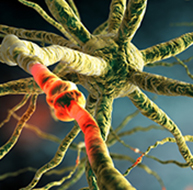






































































.jpg)















